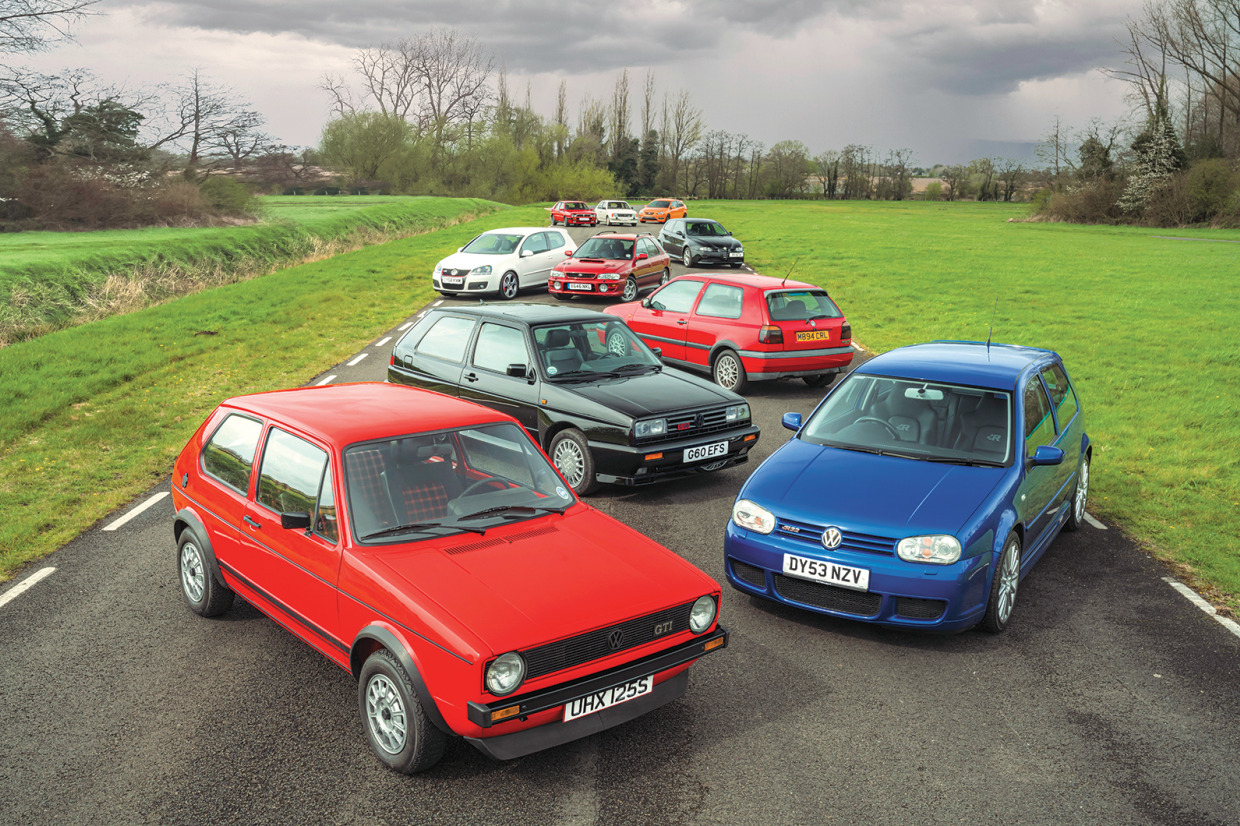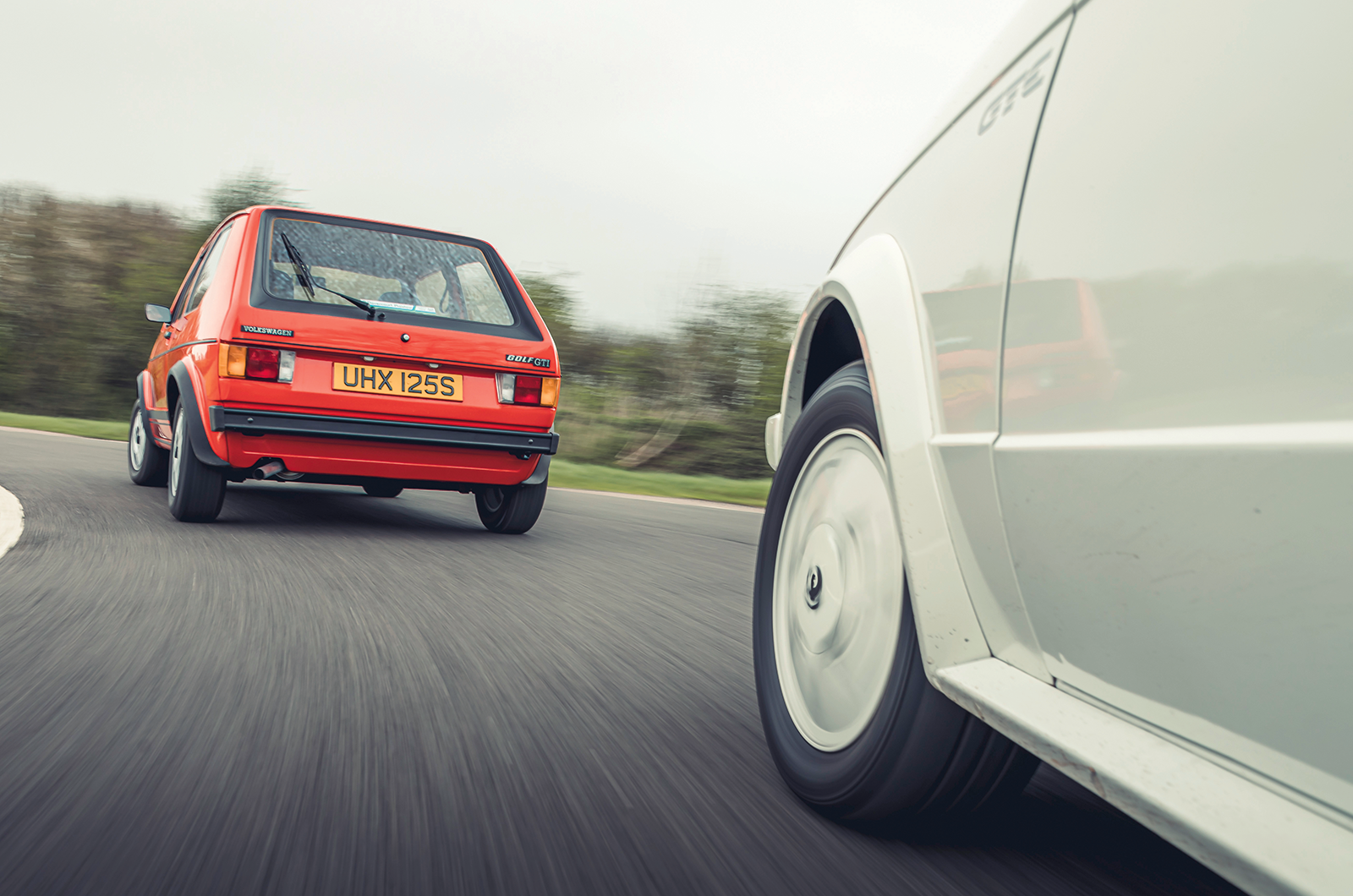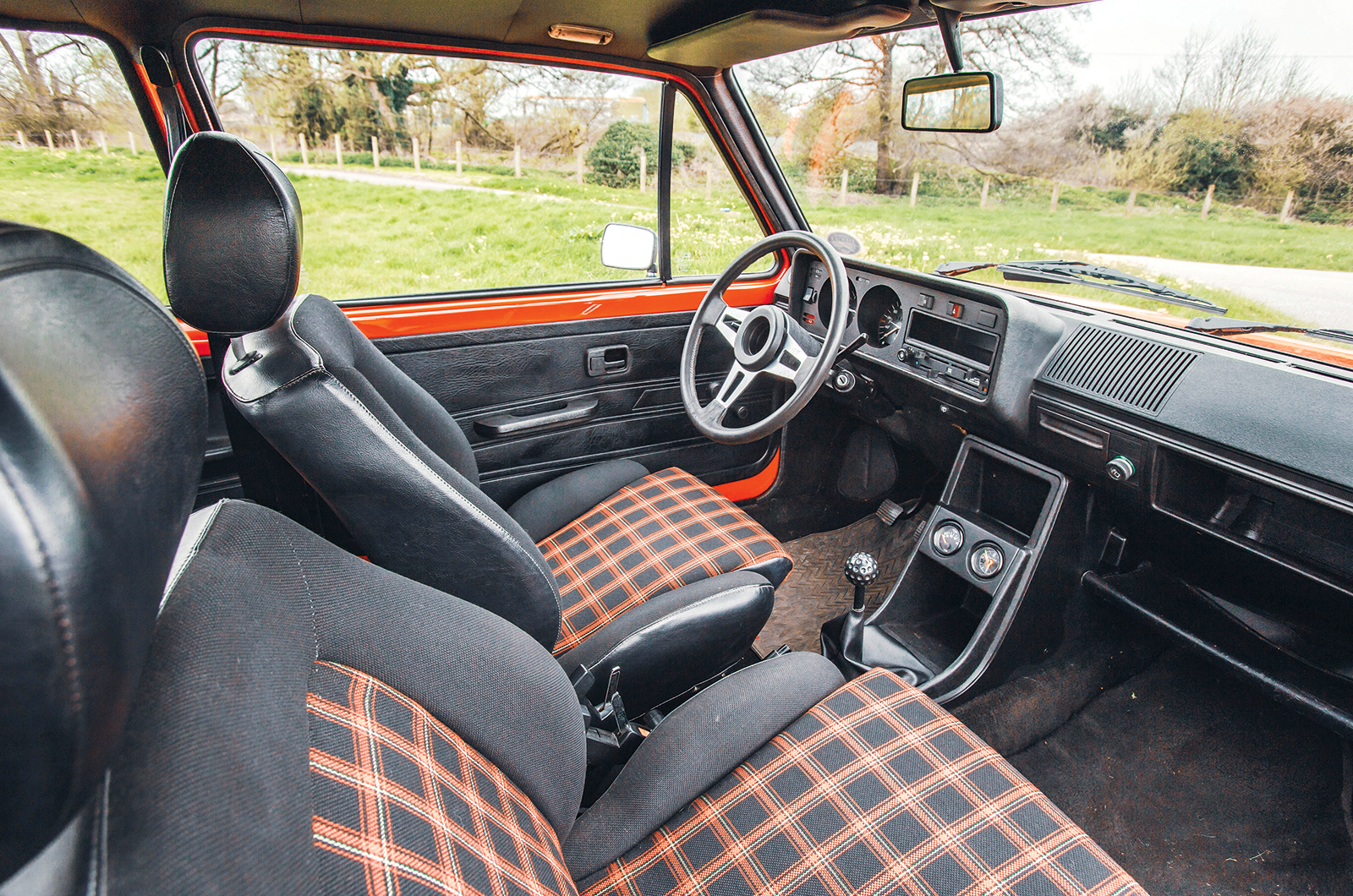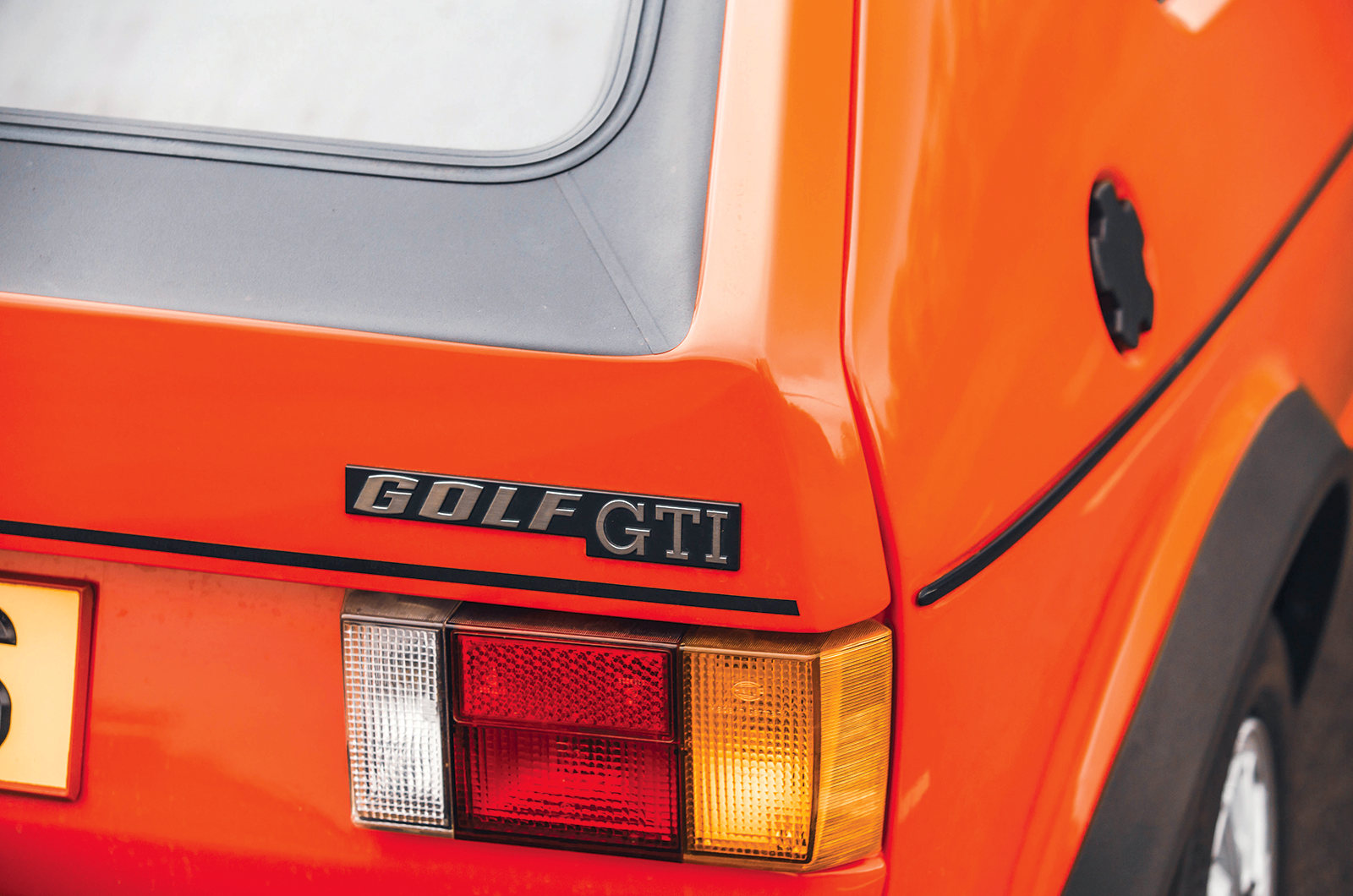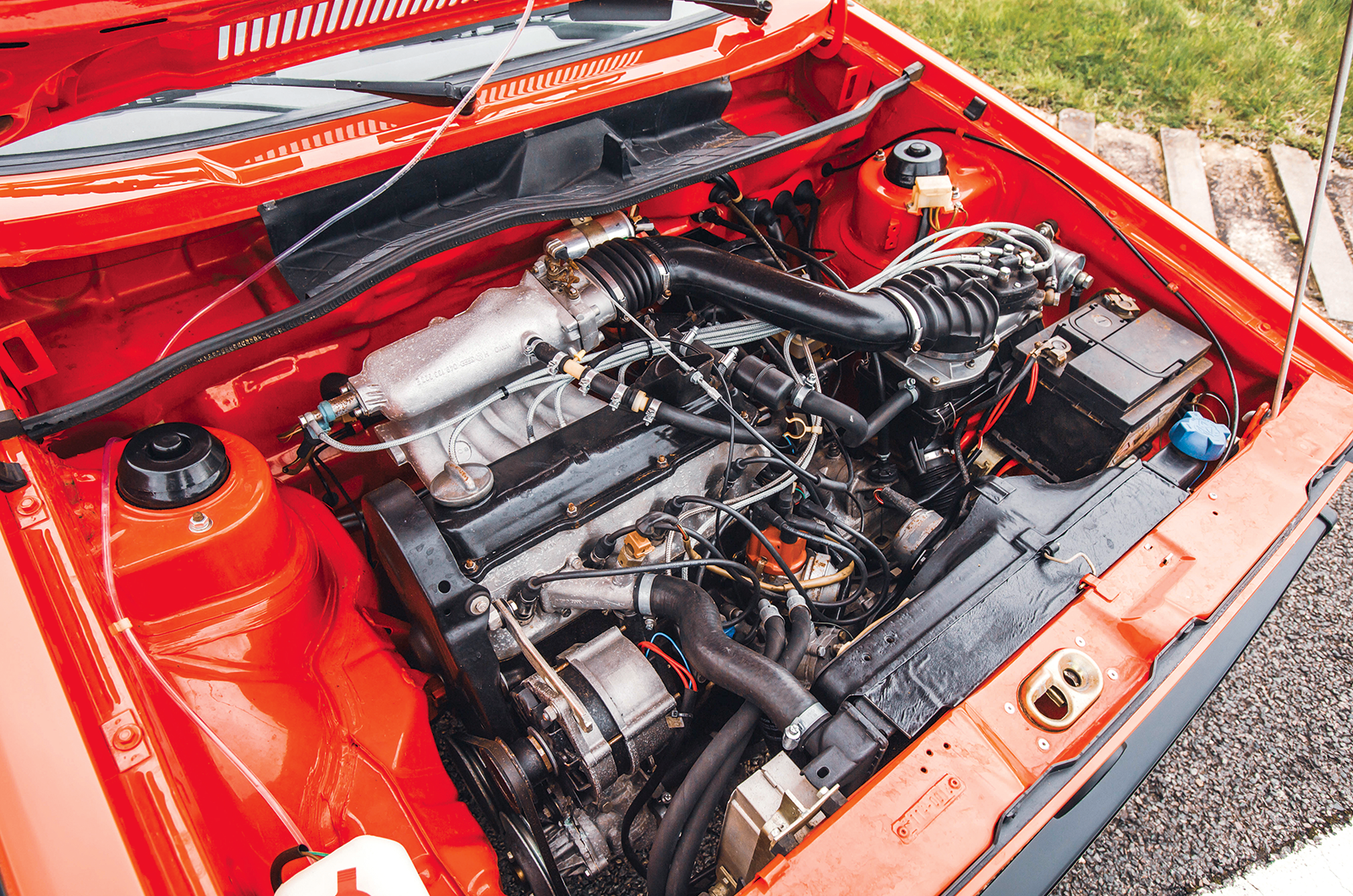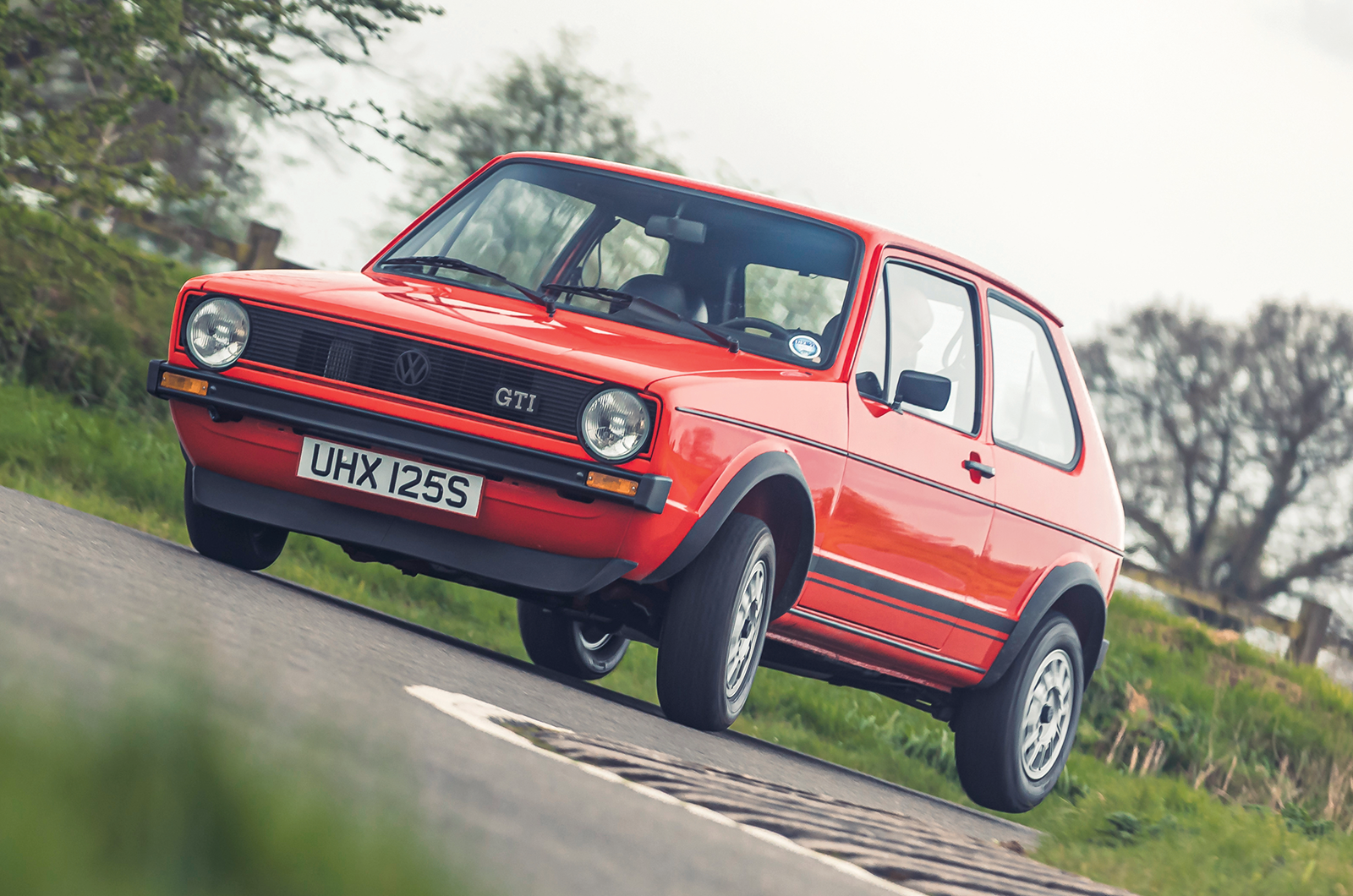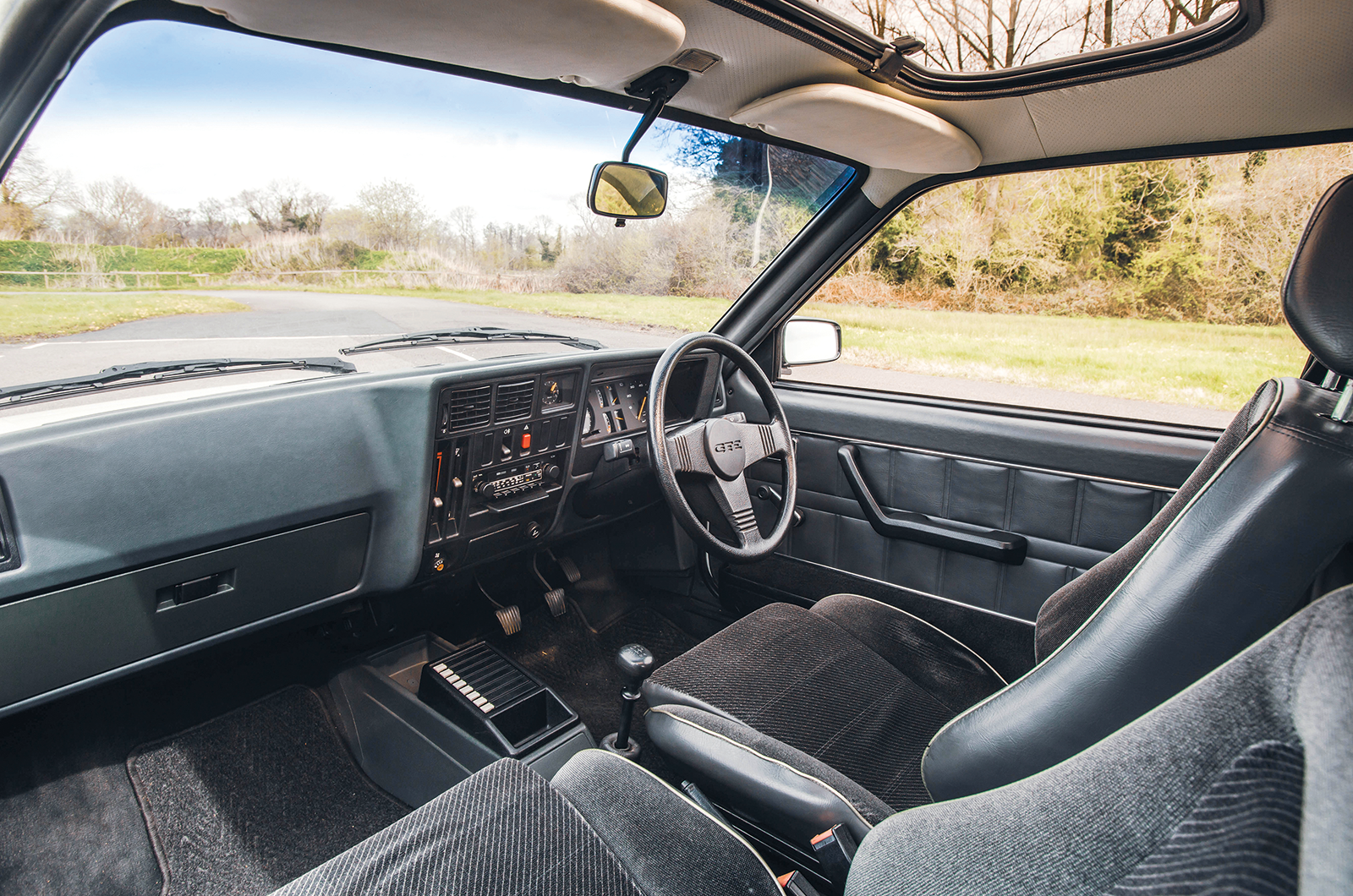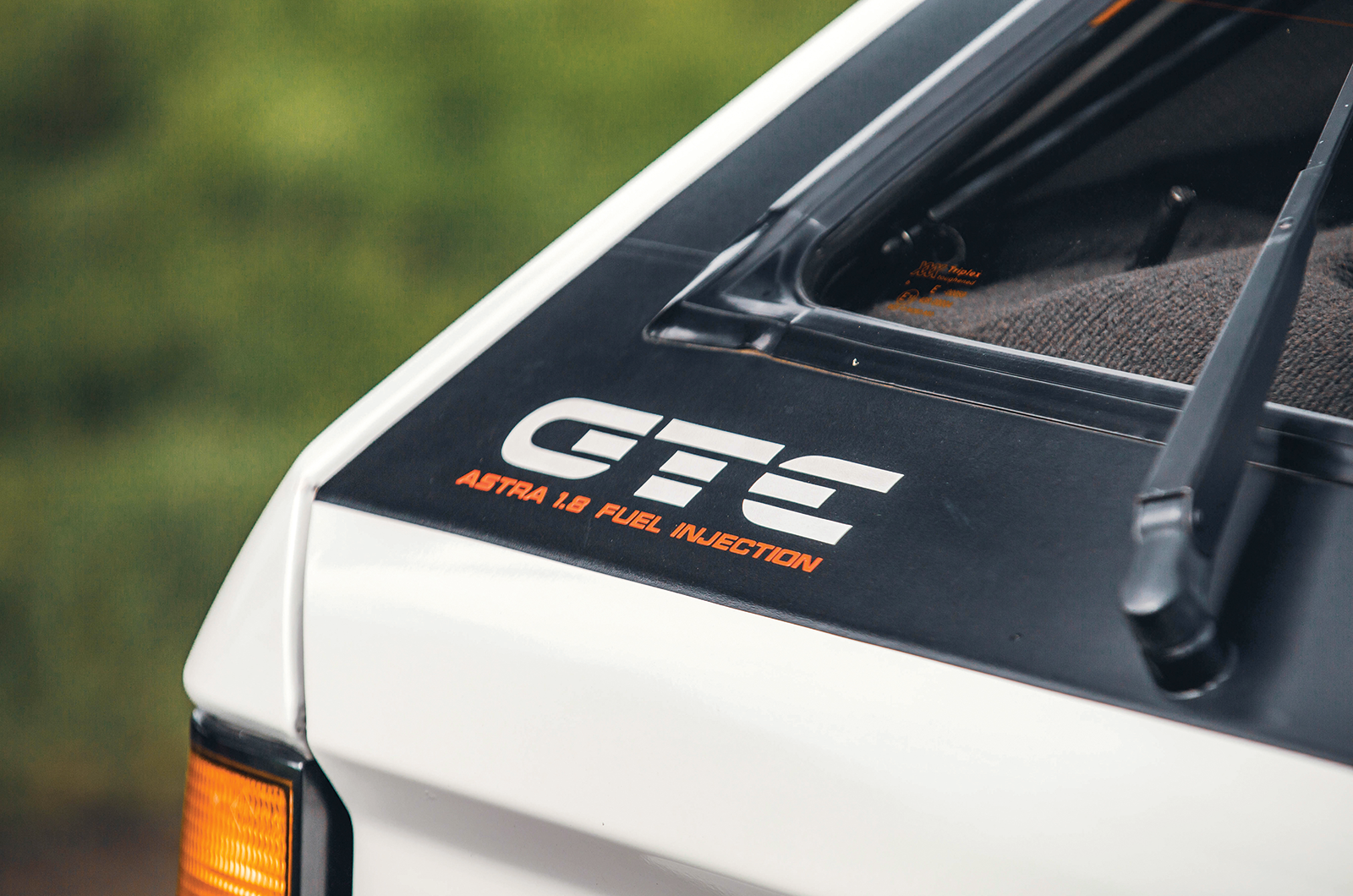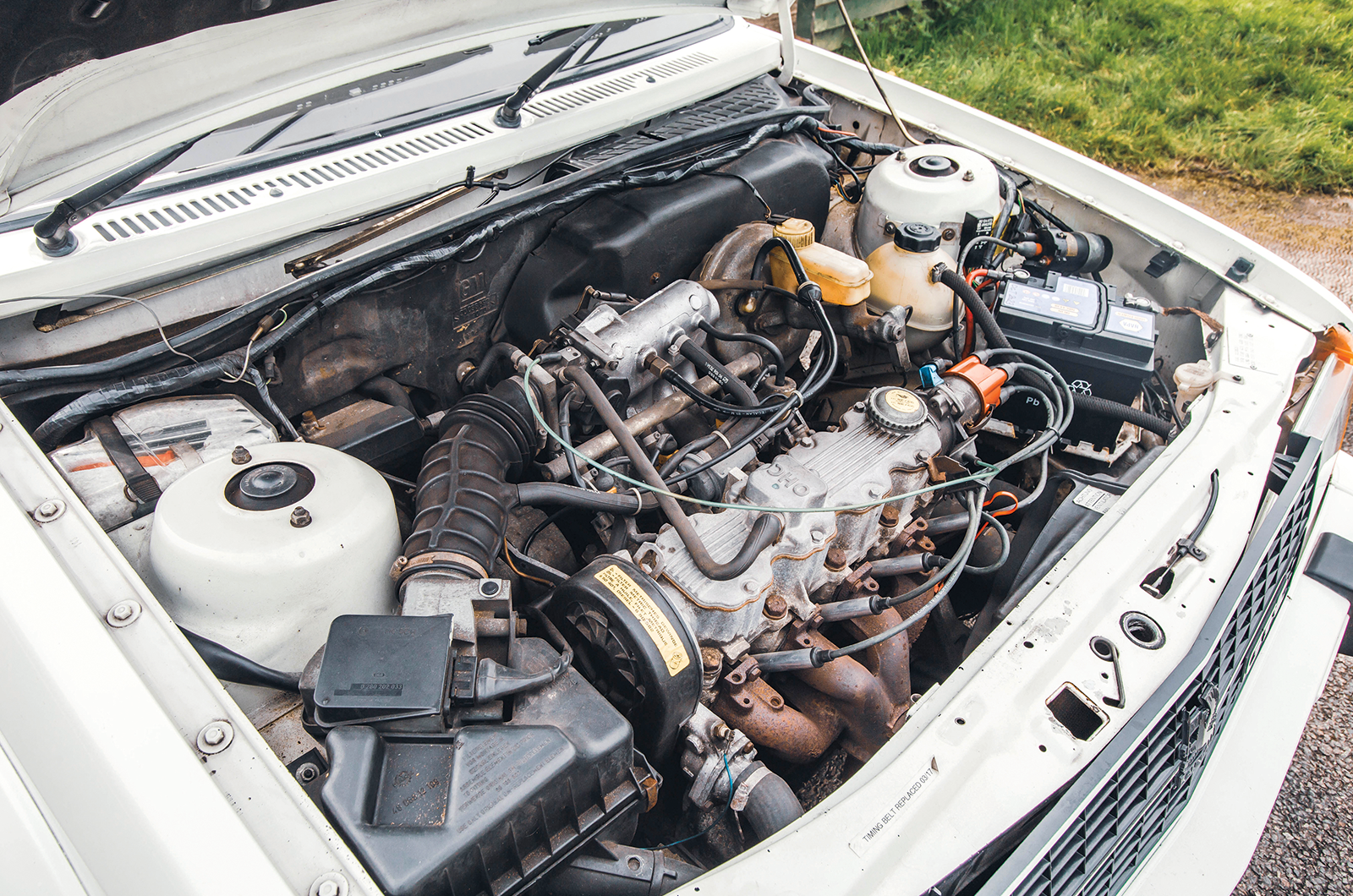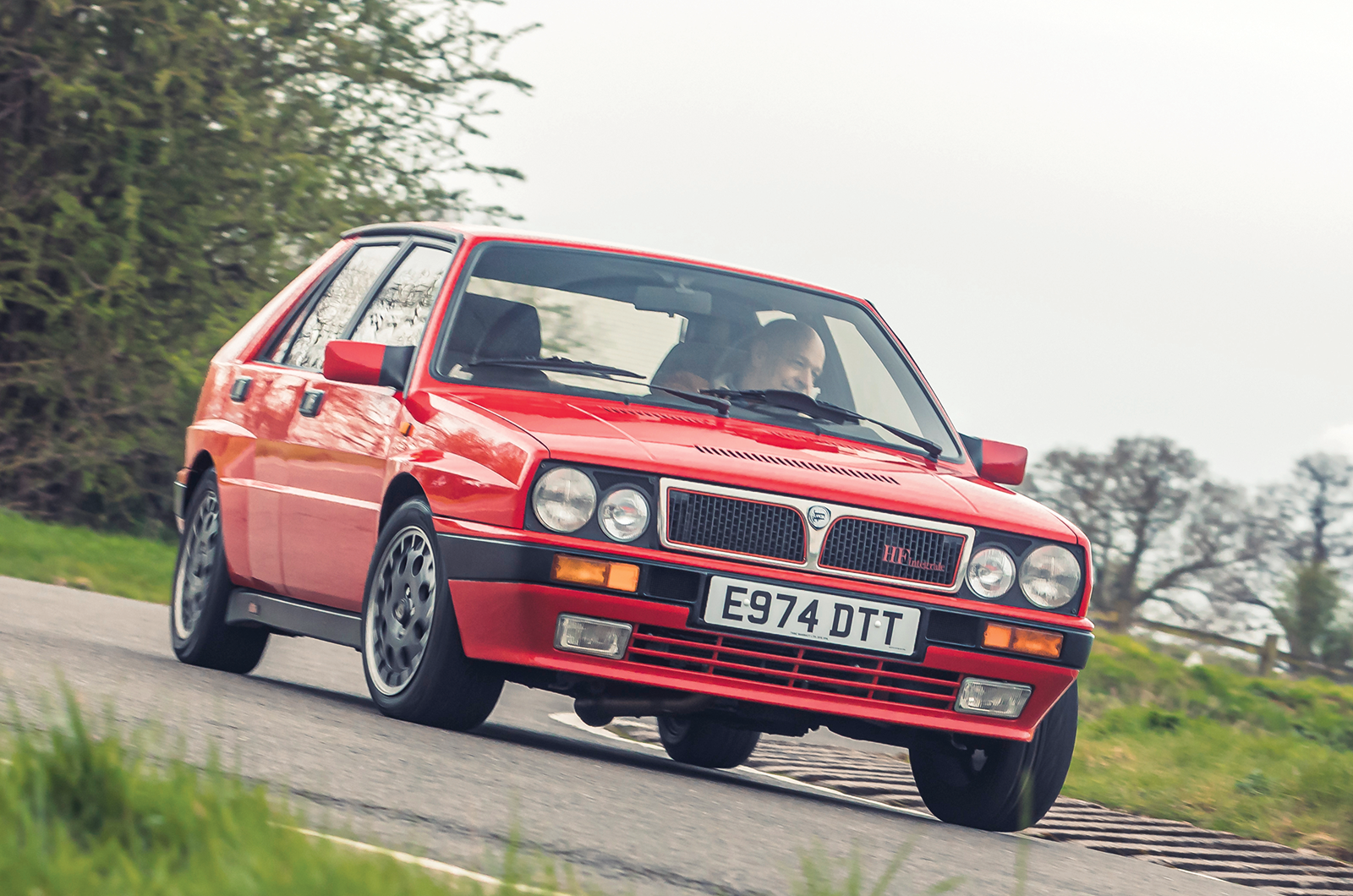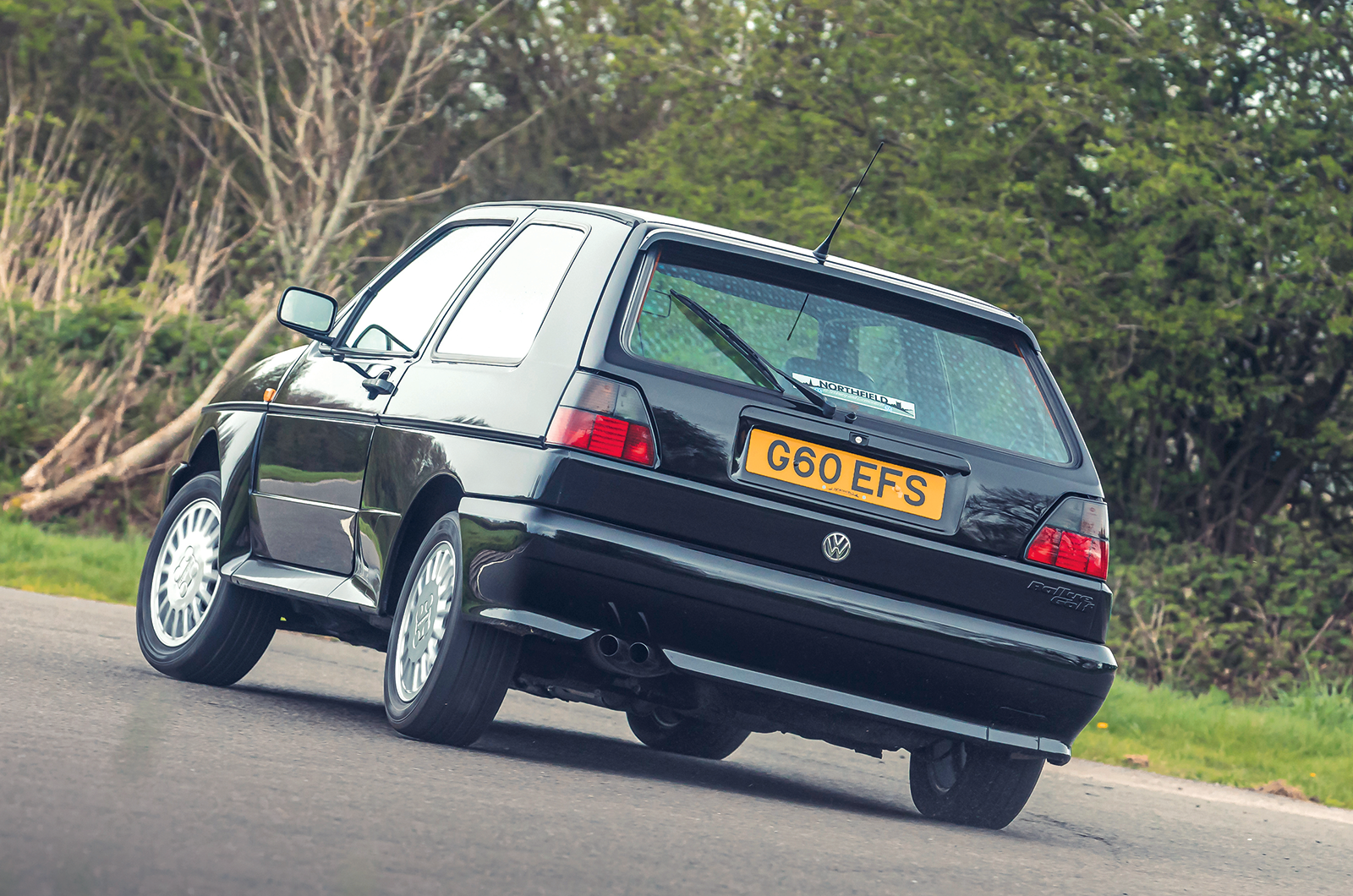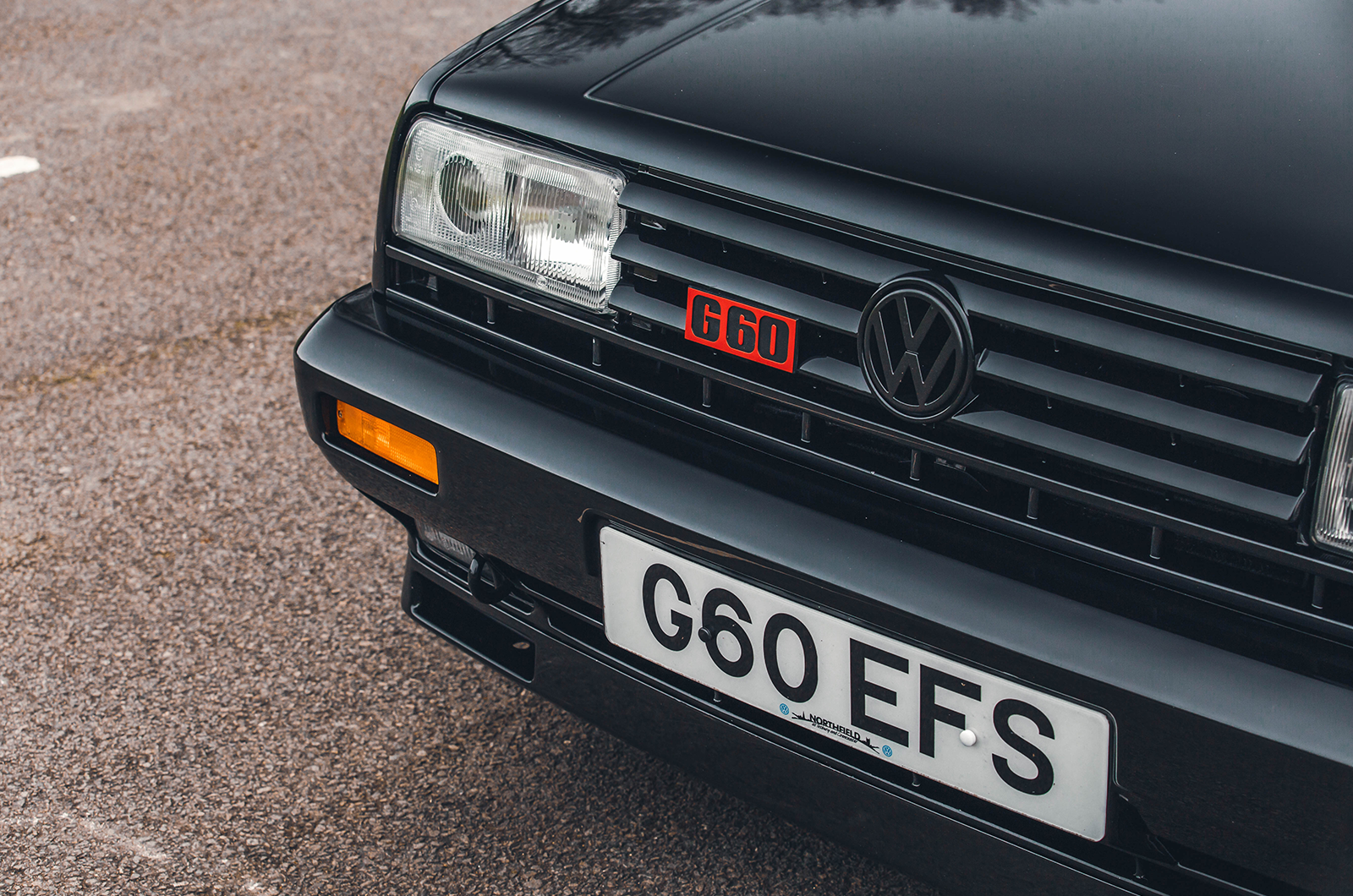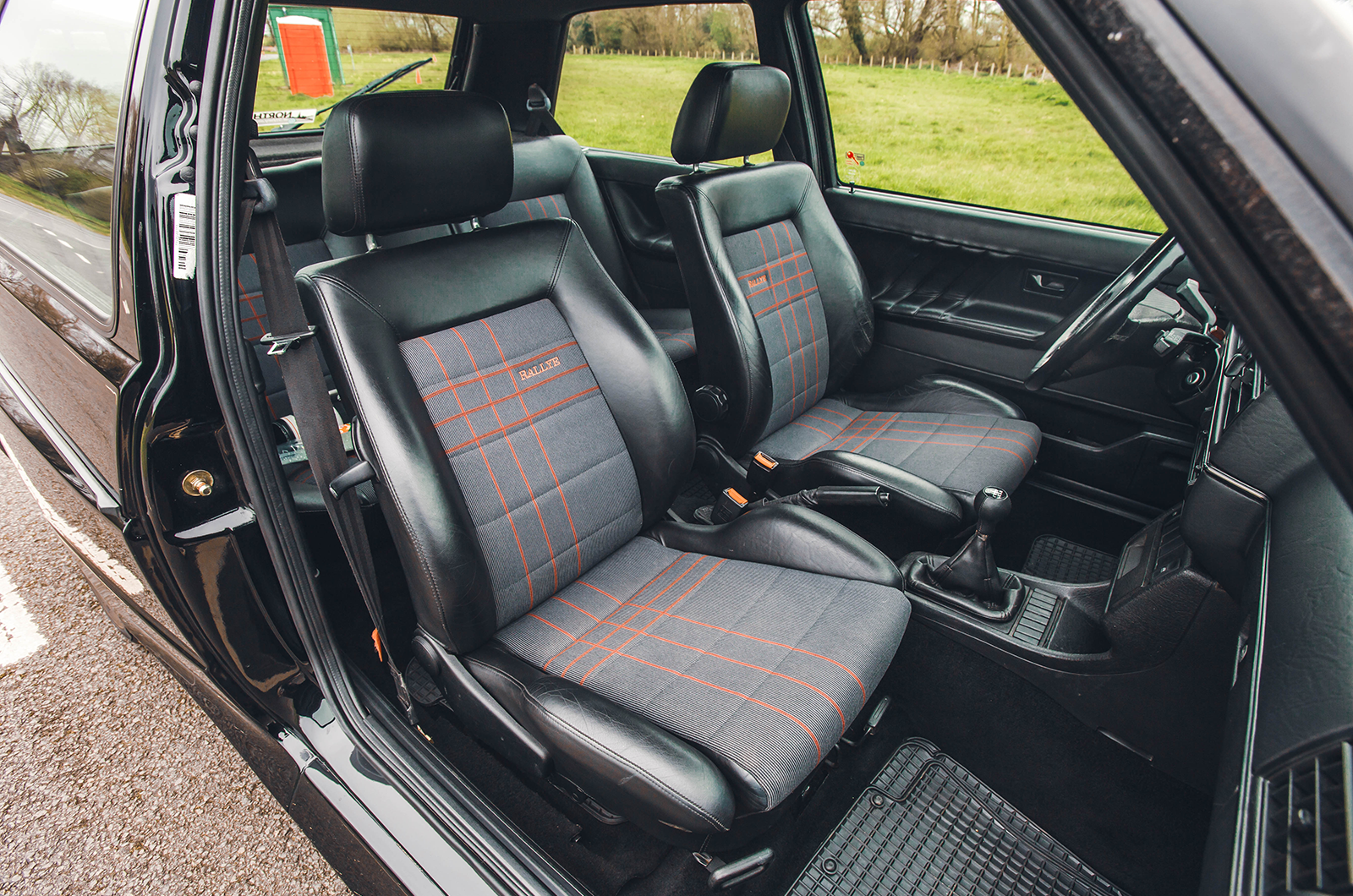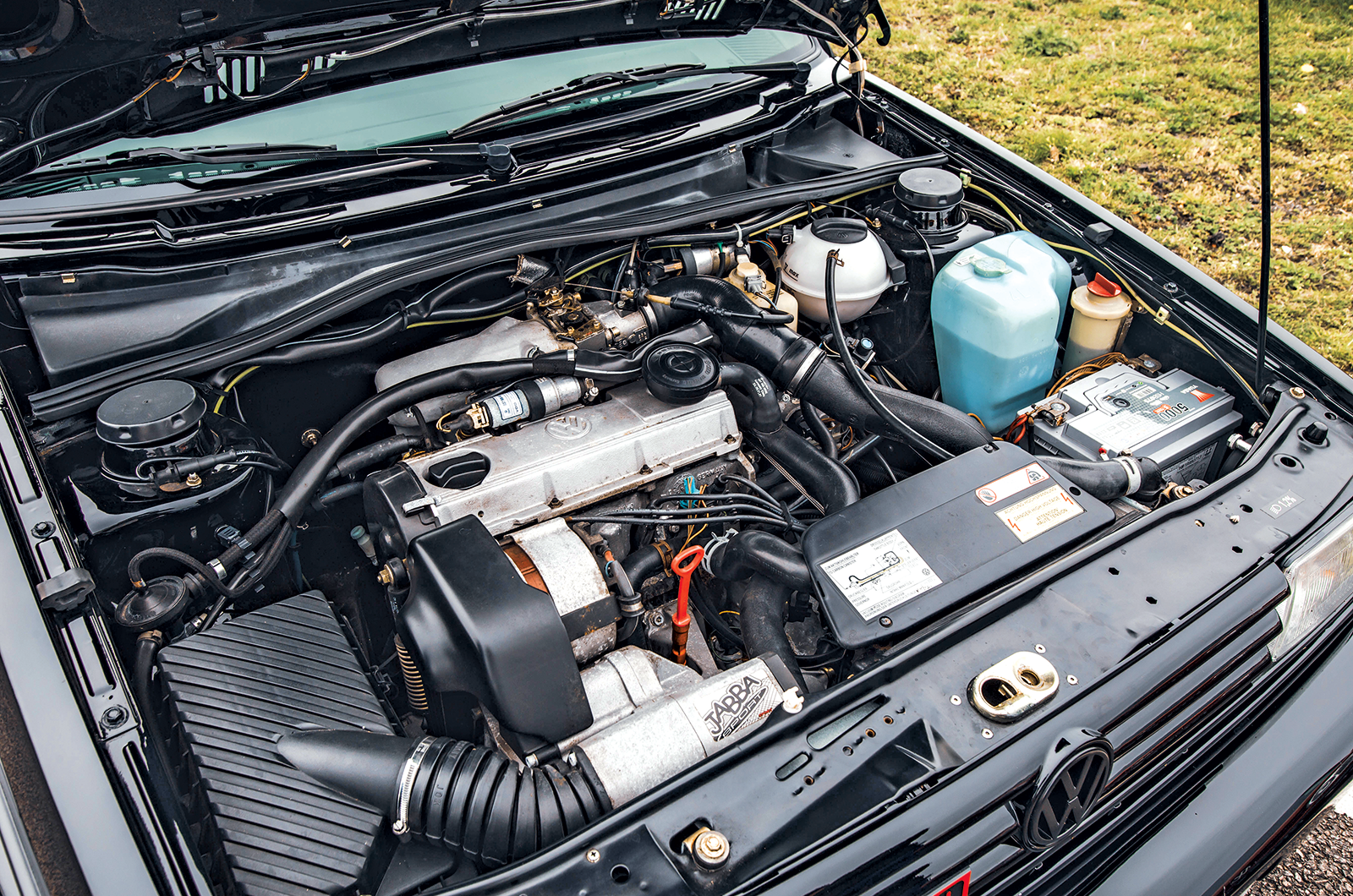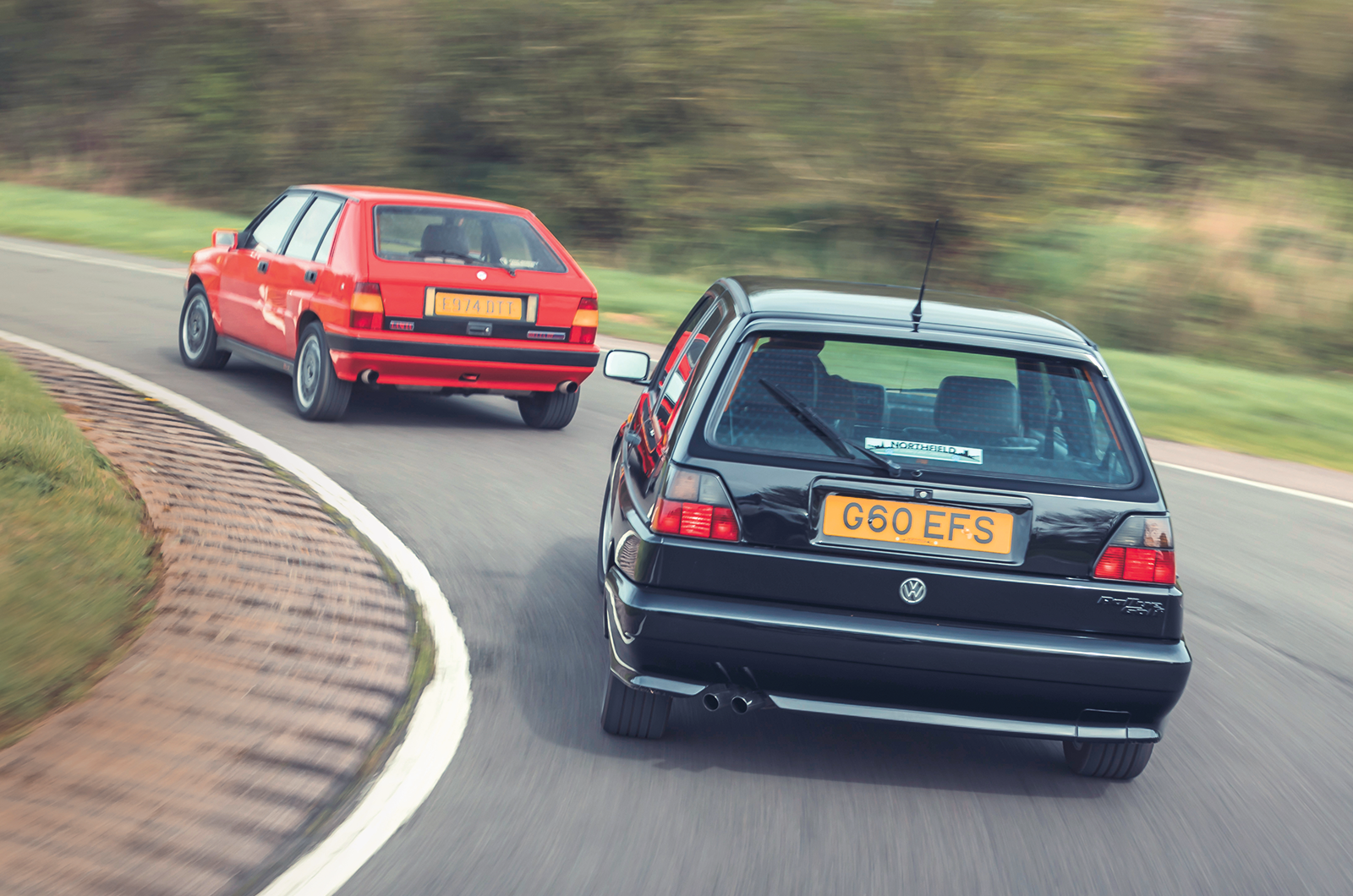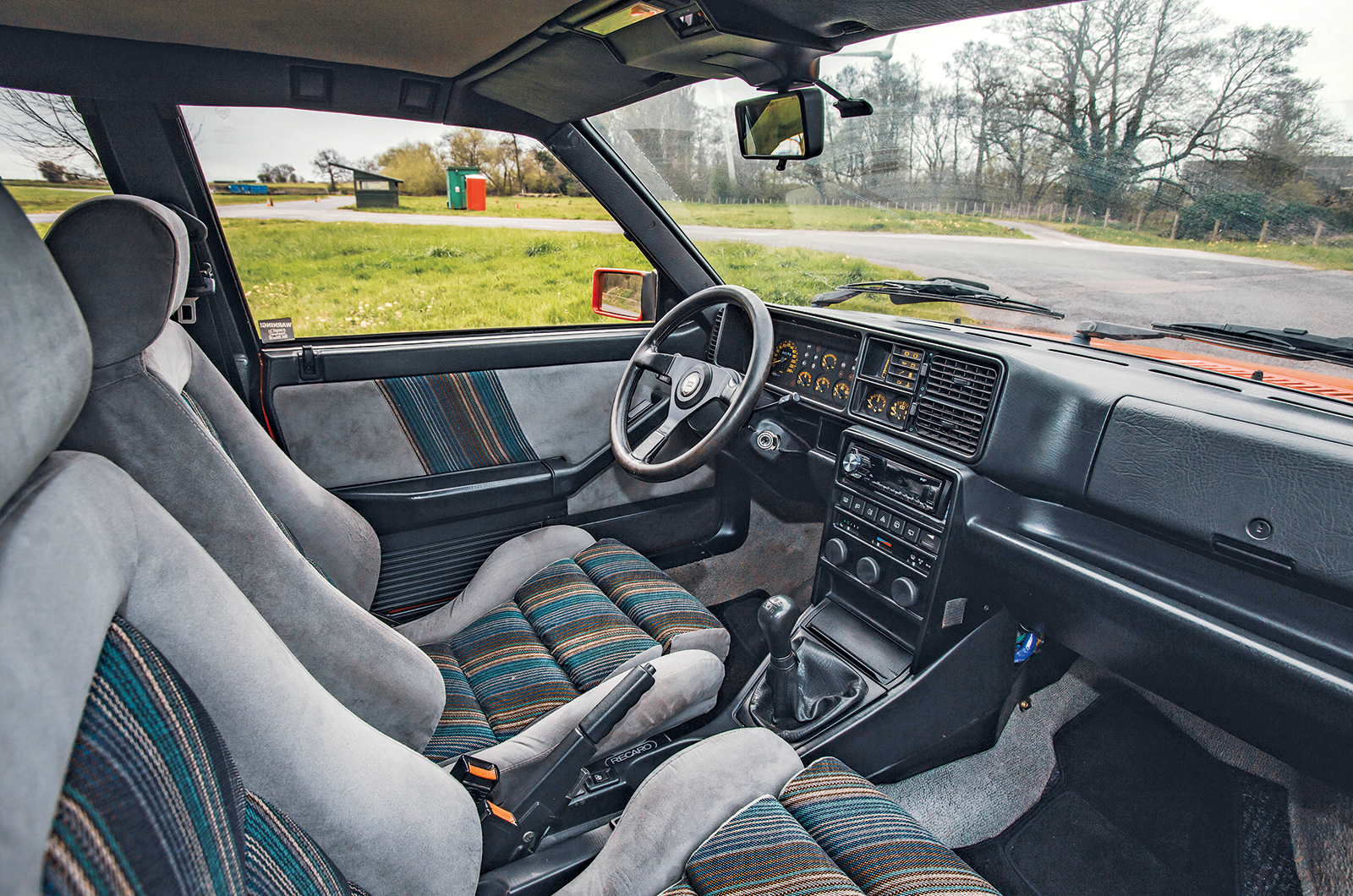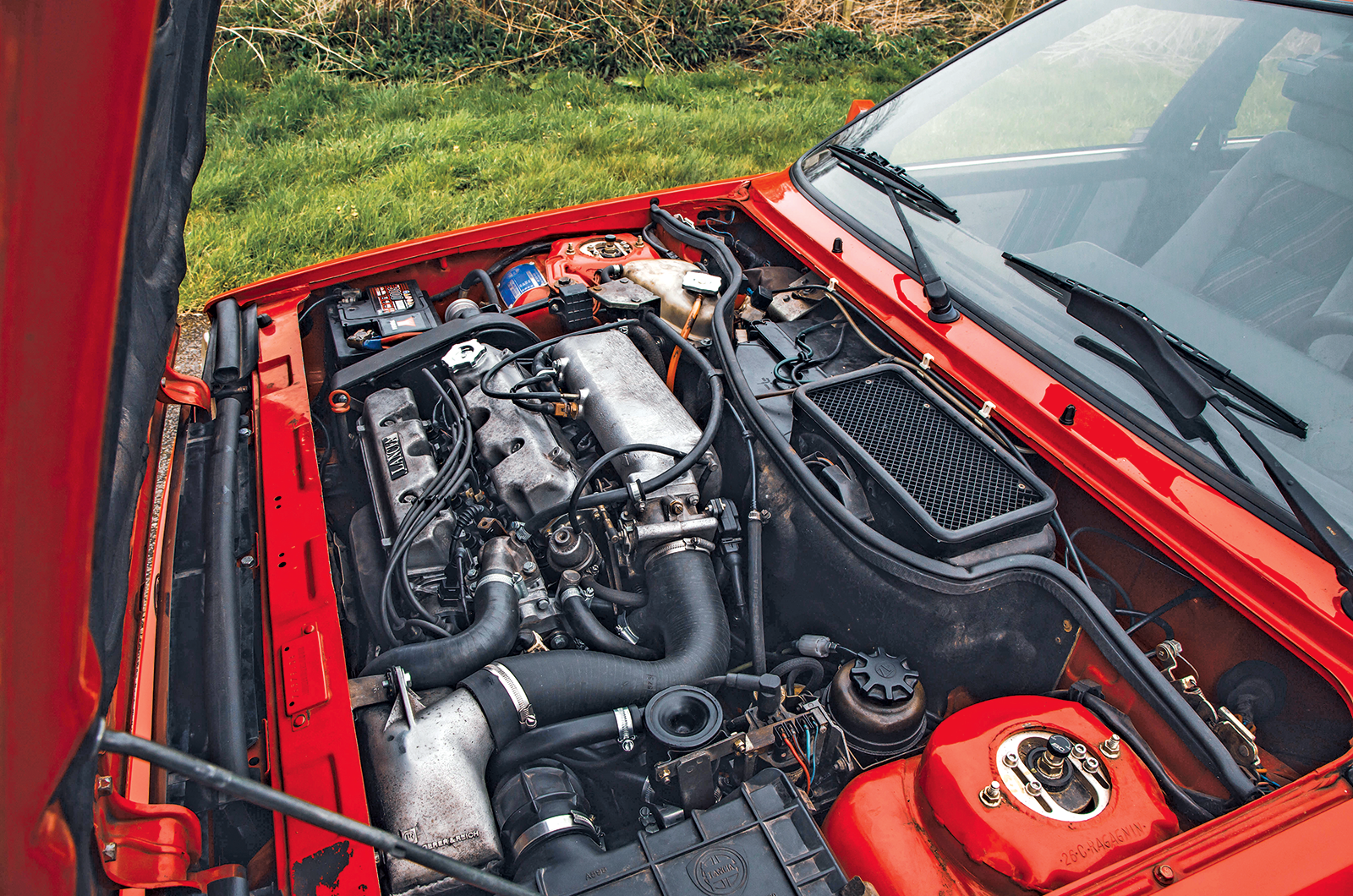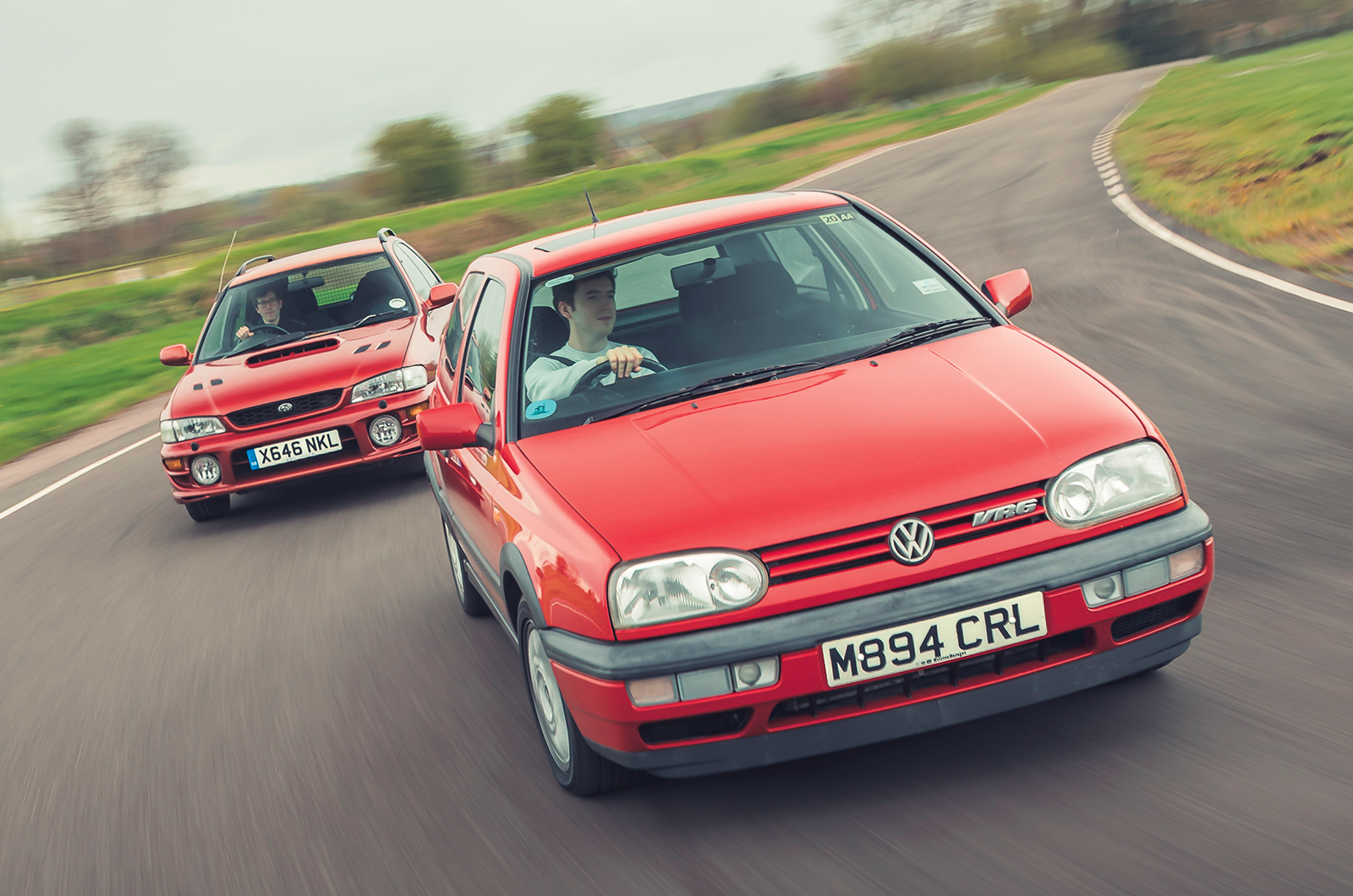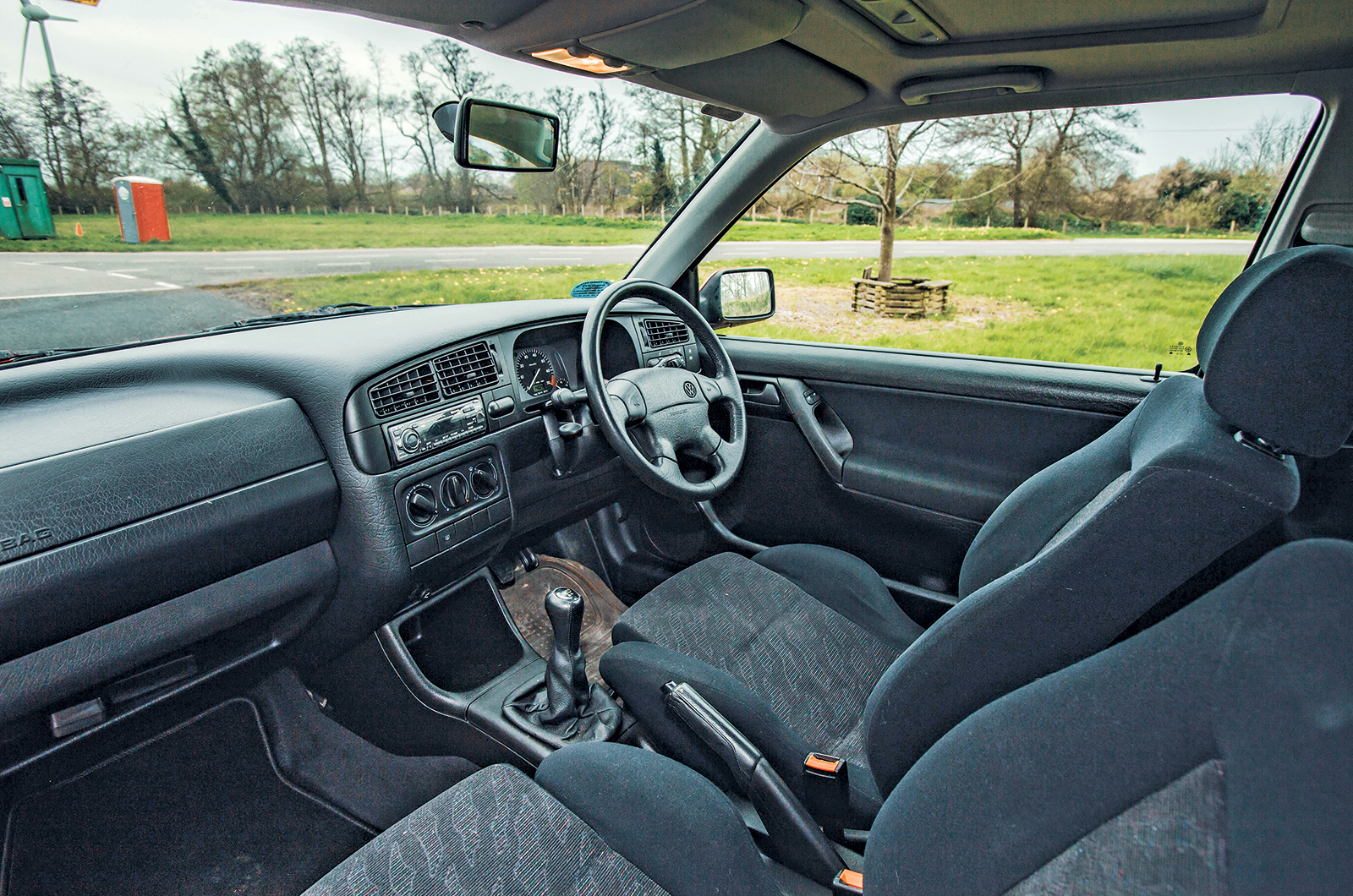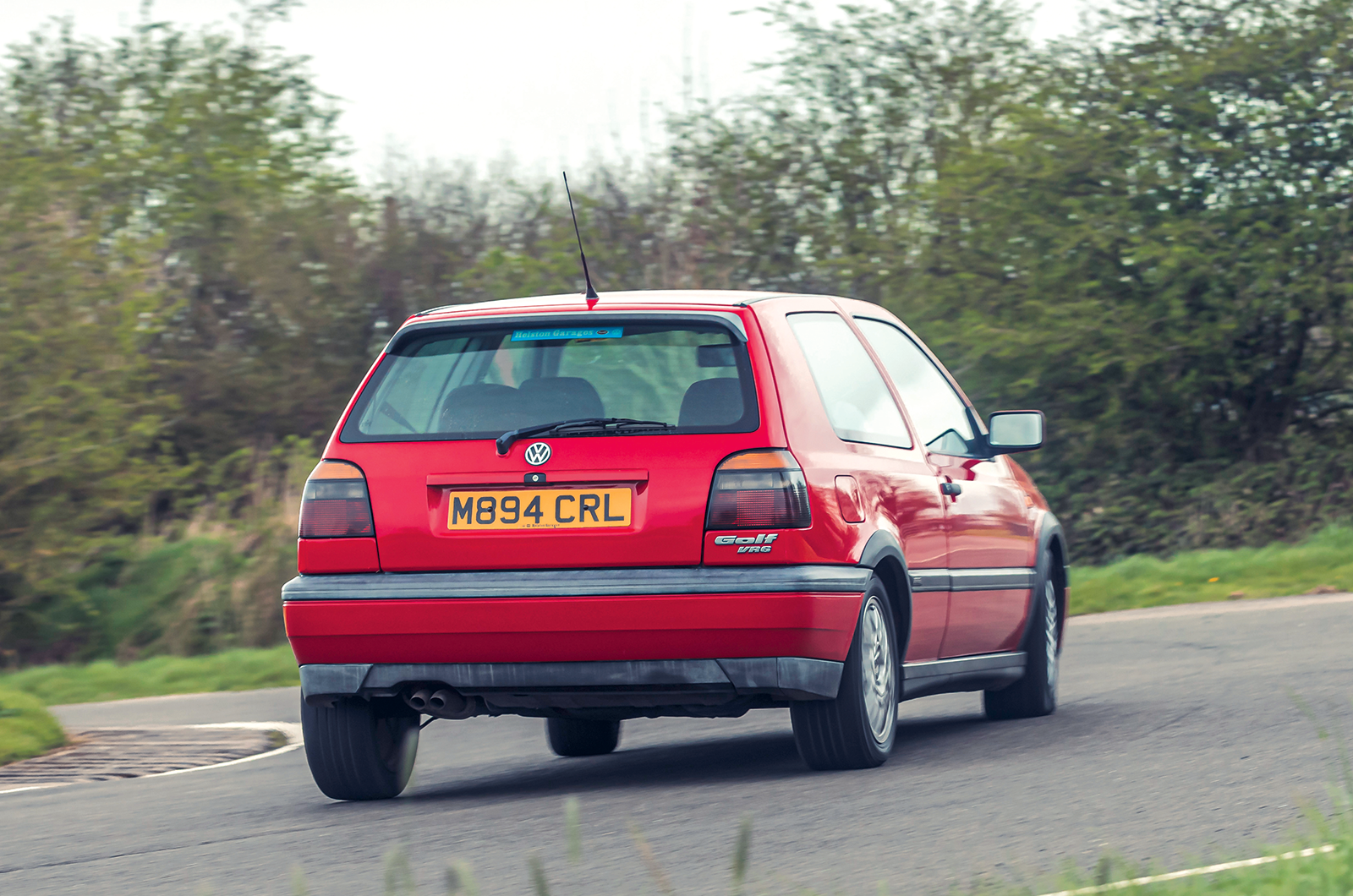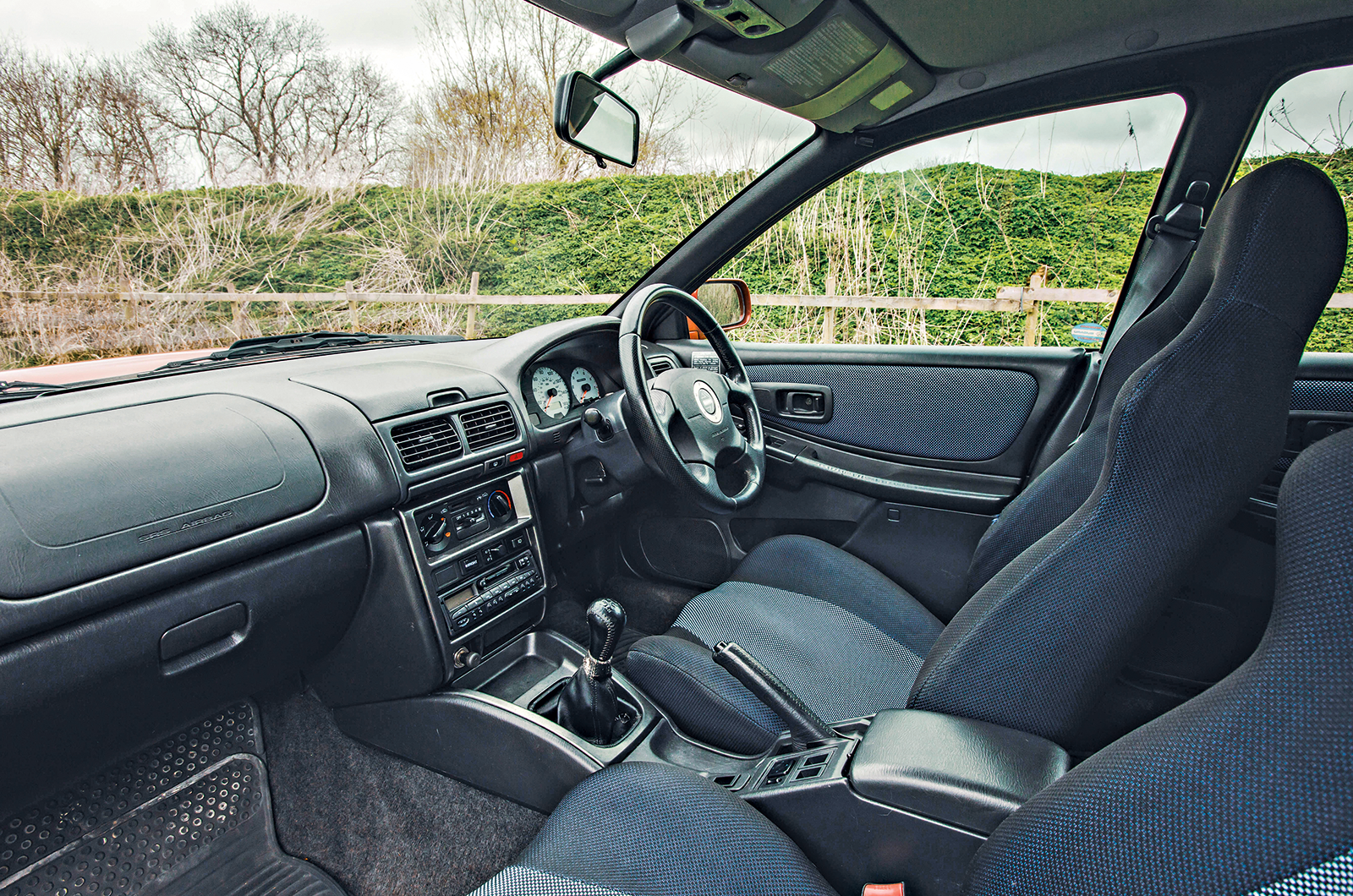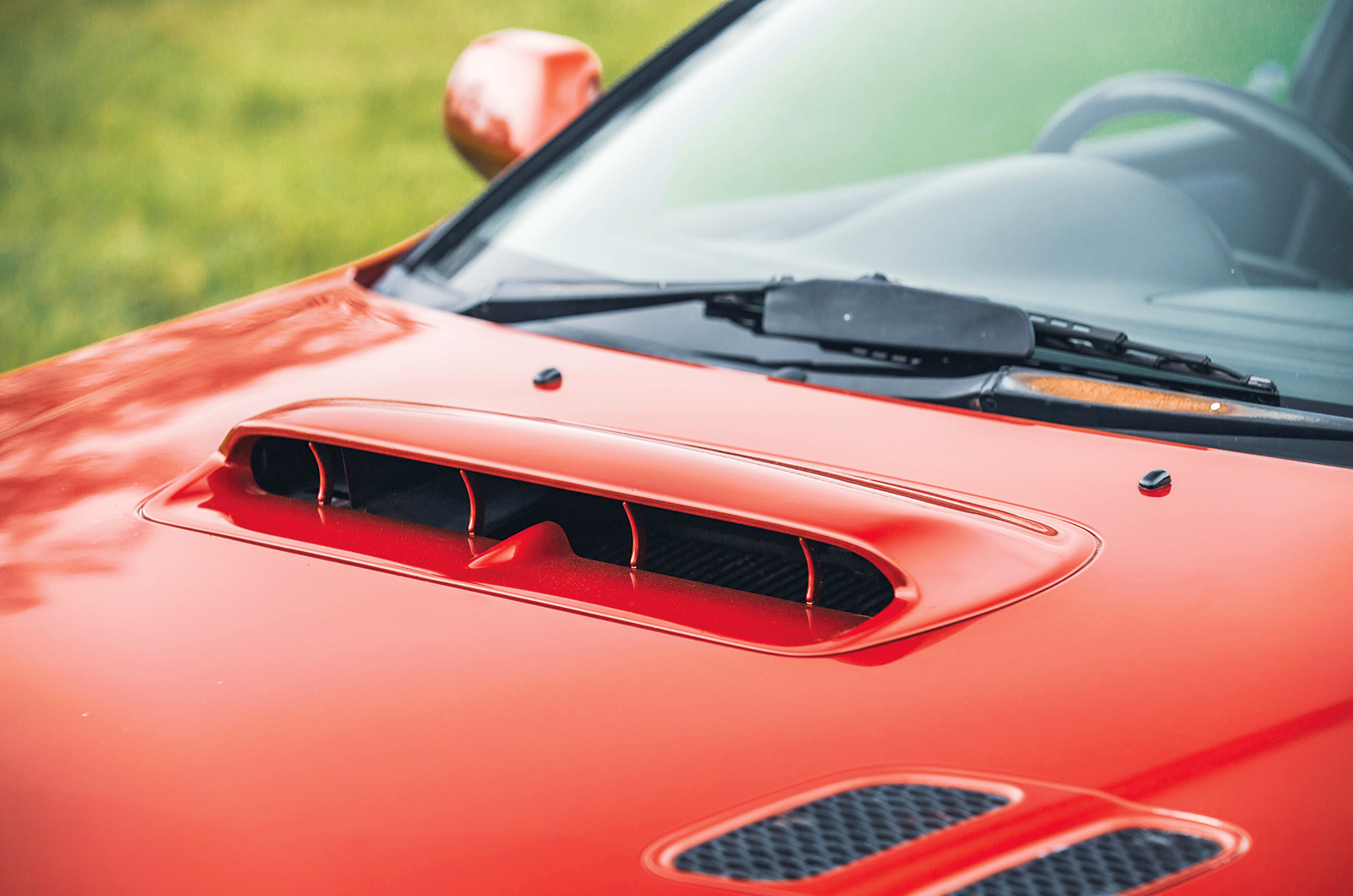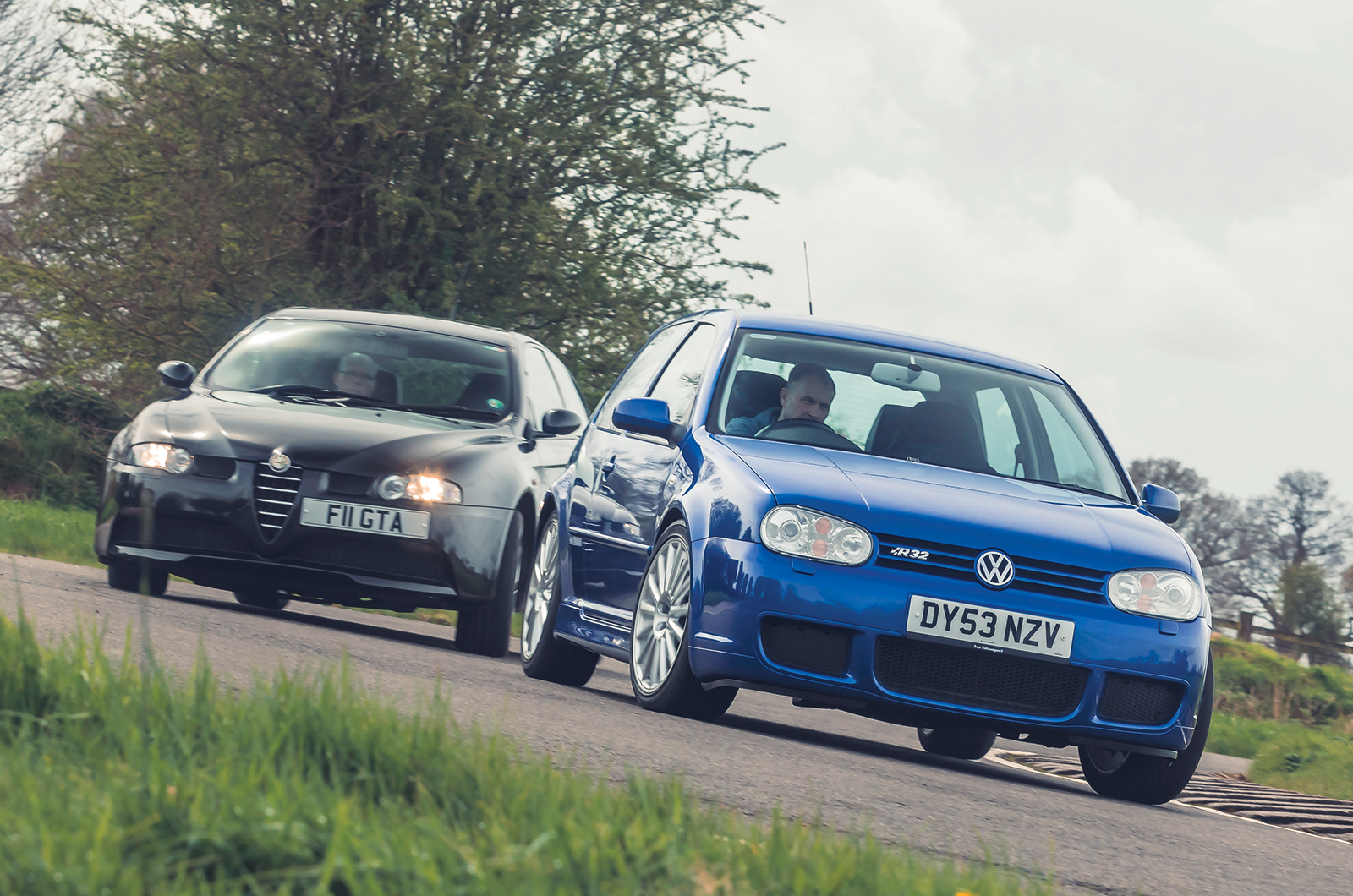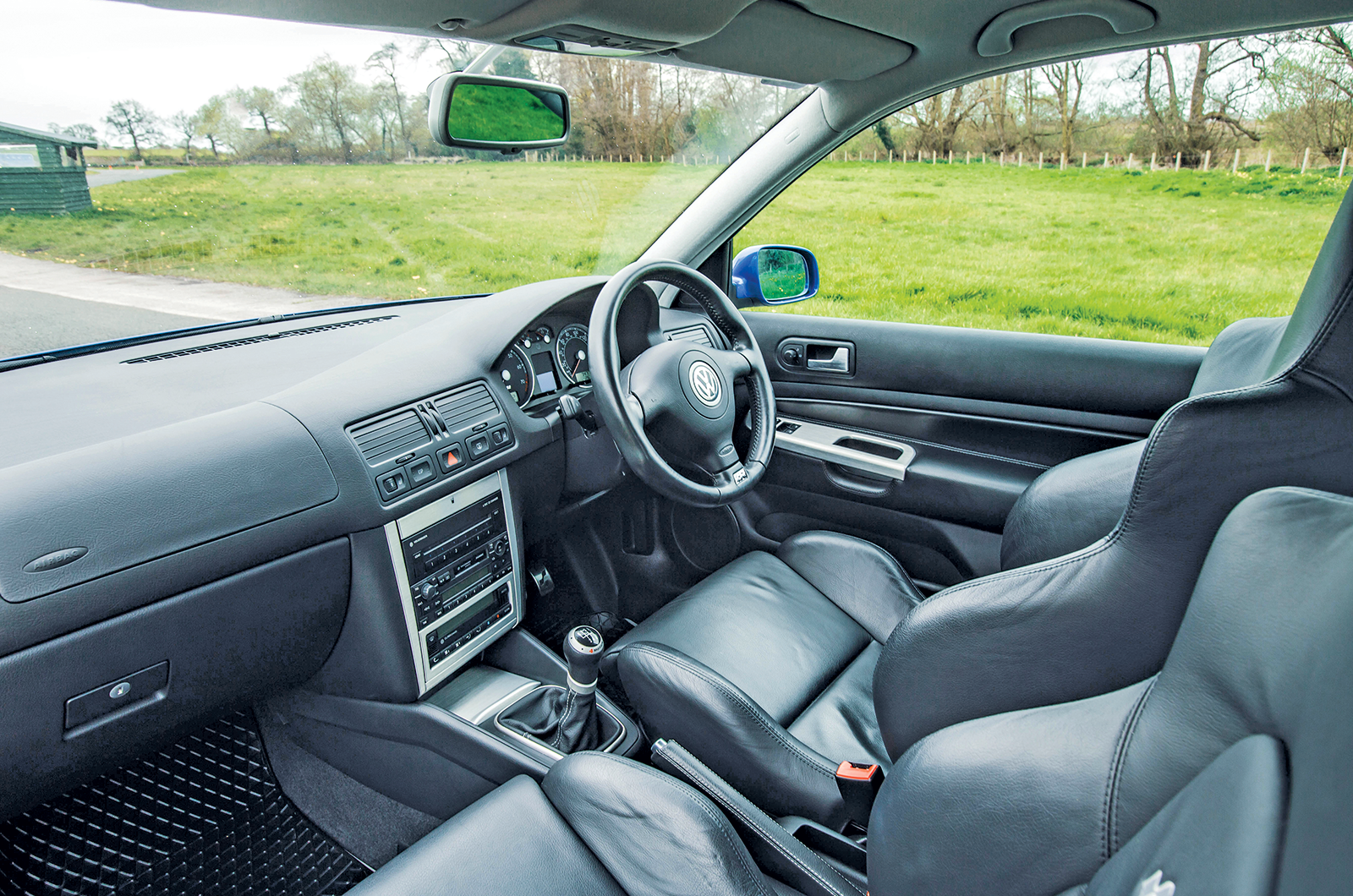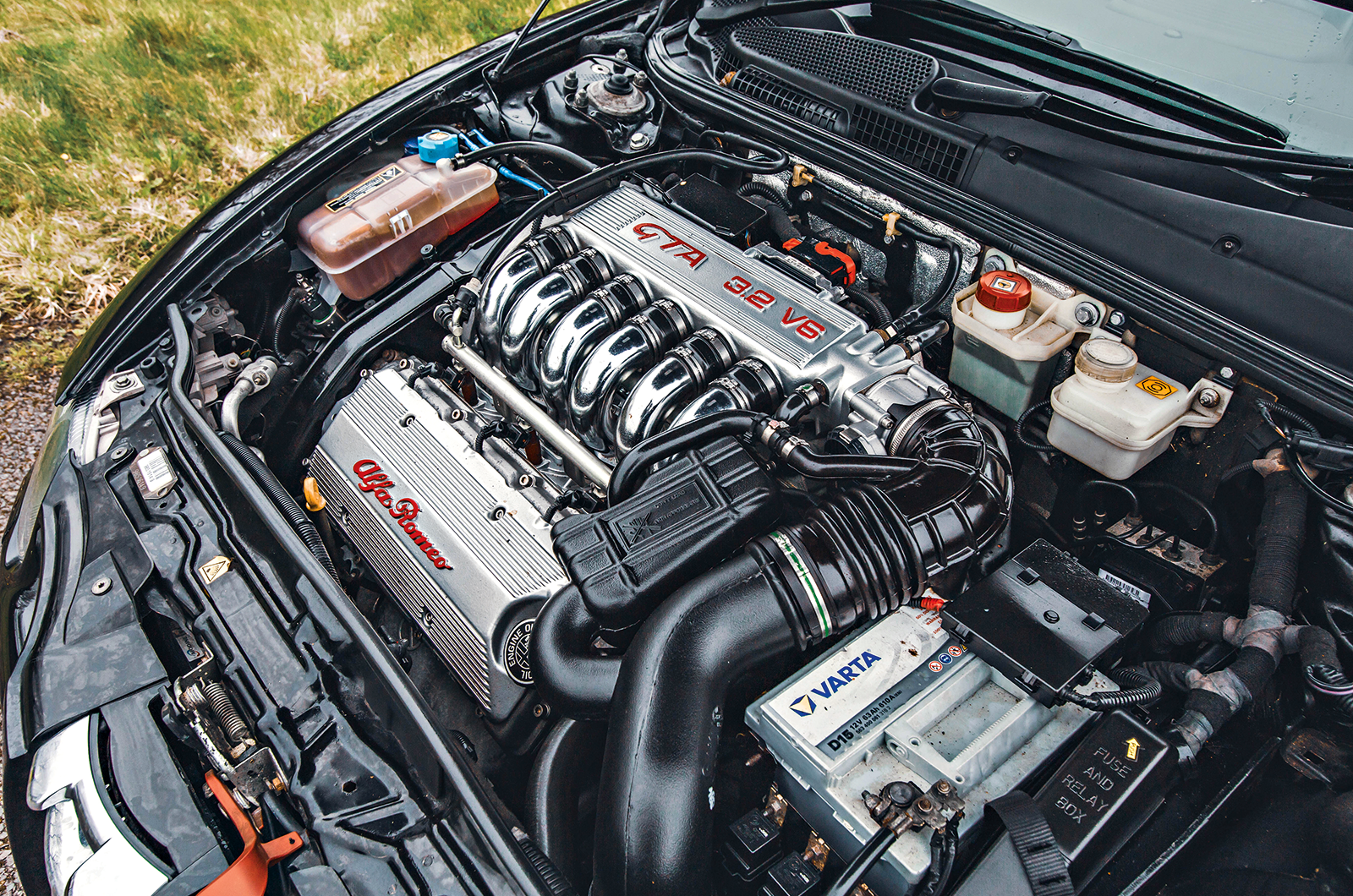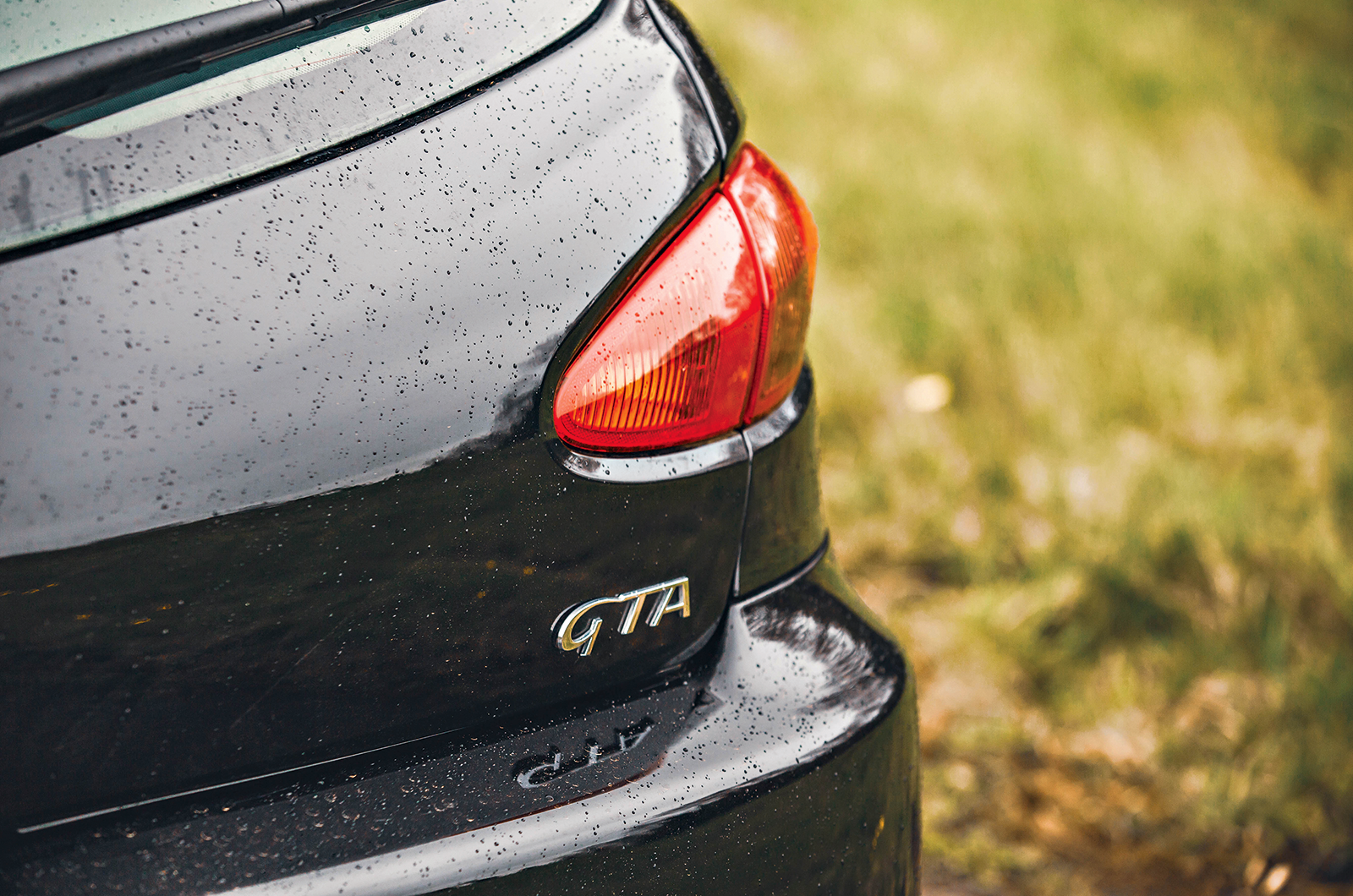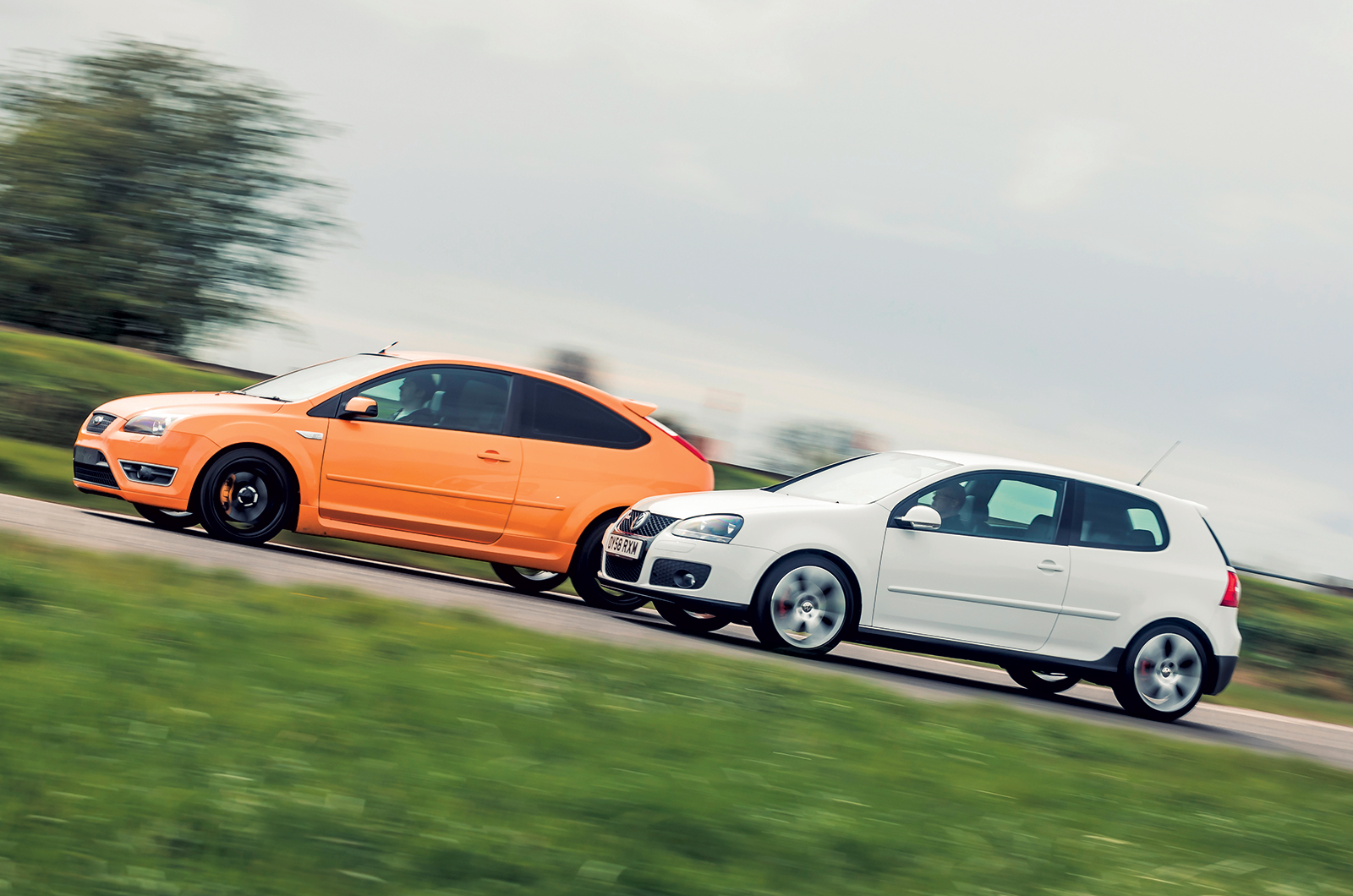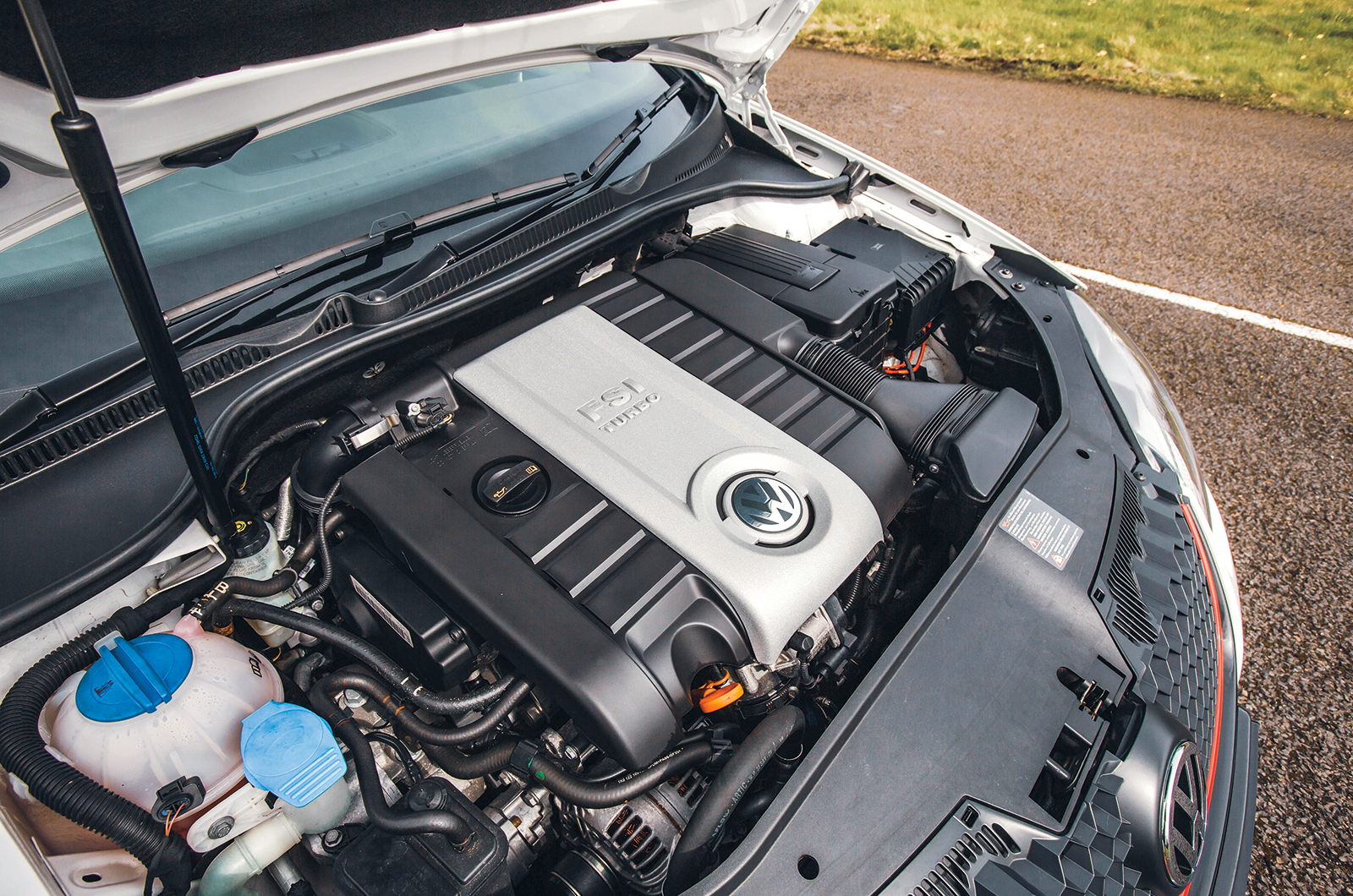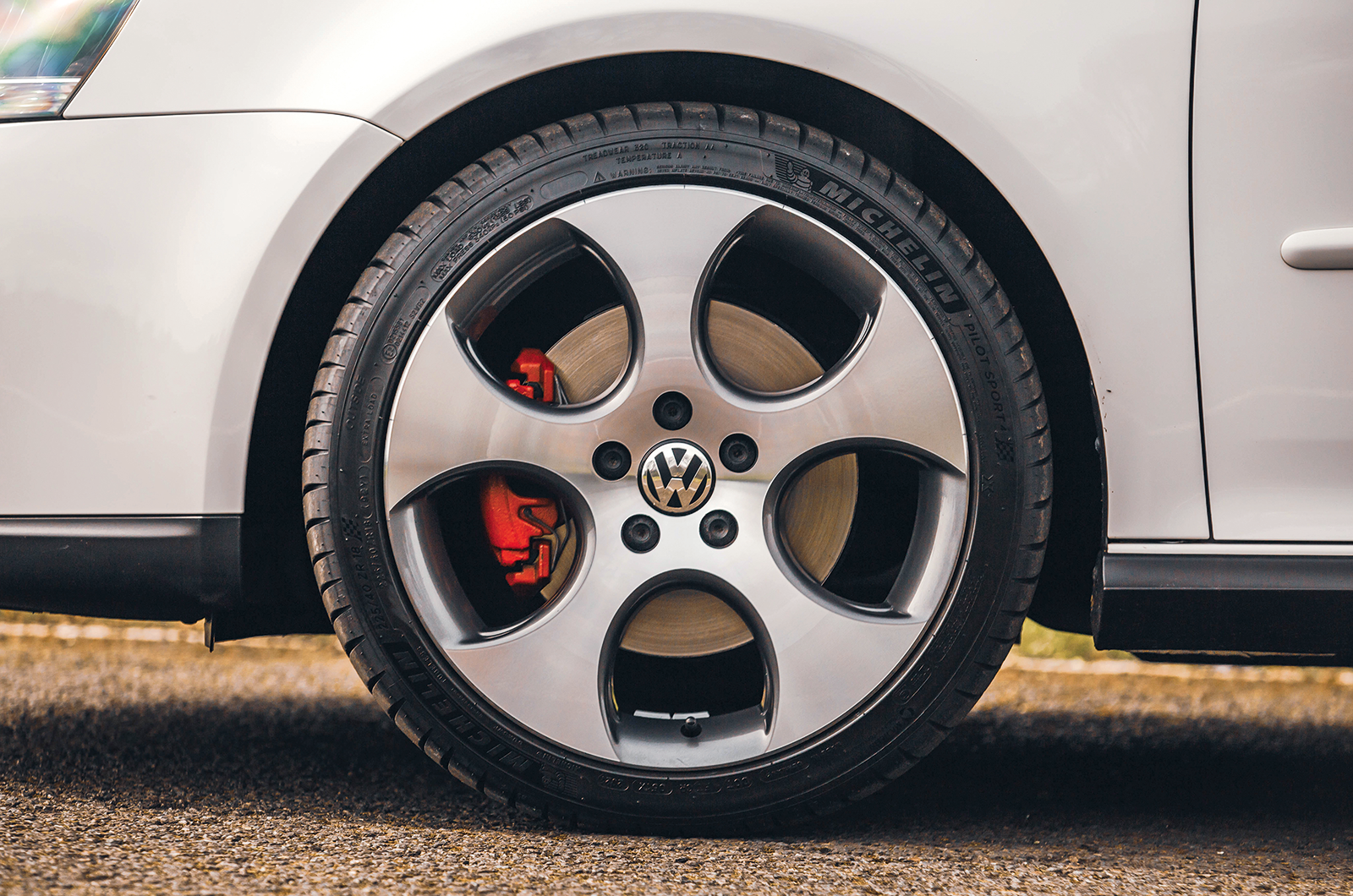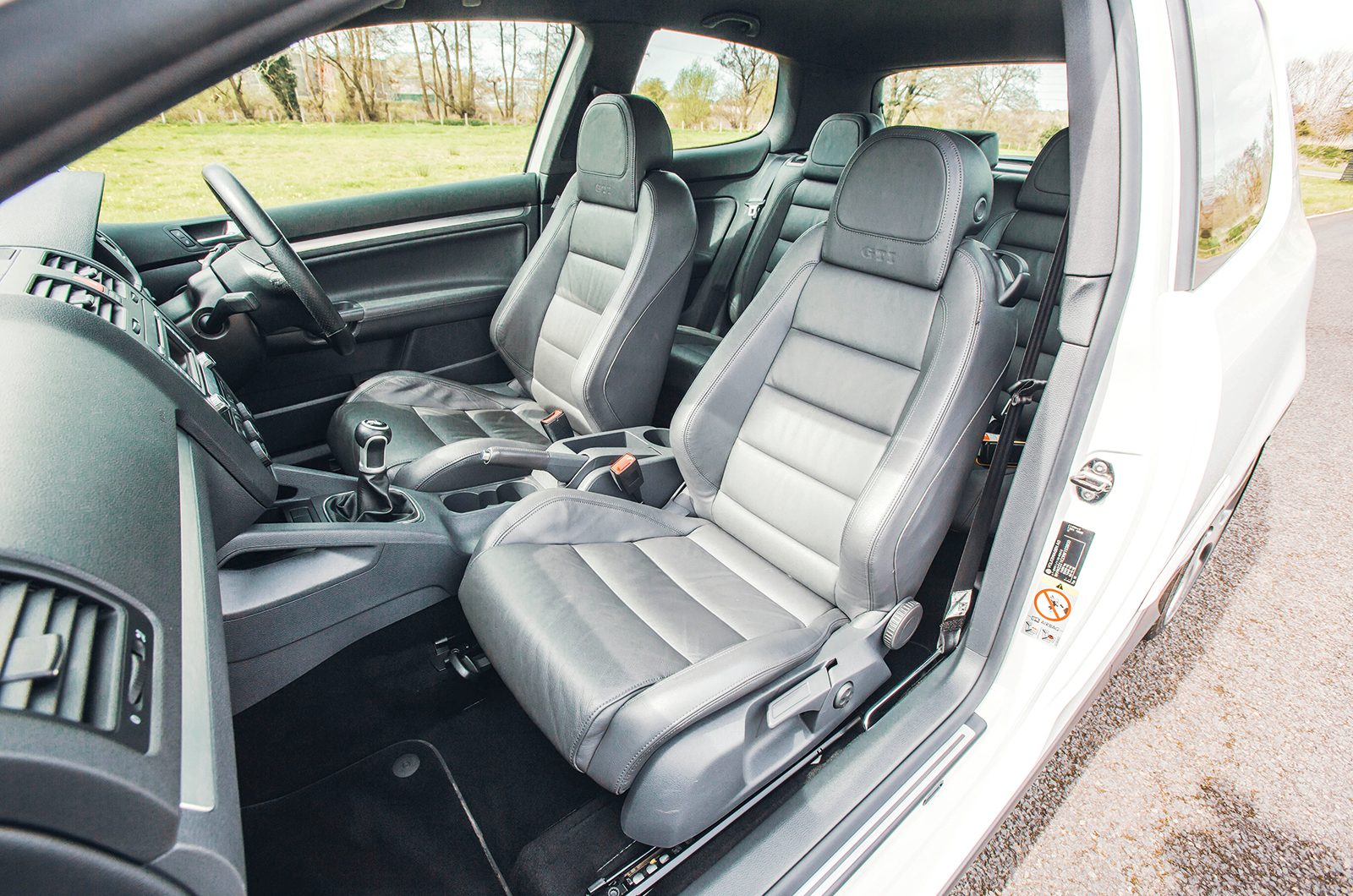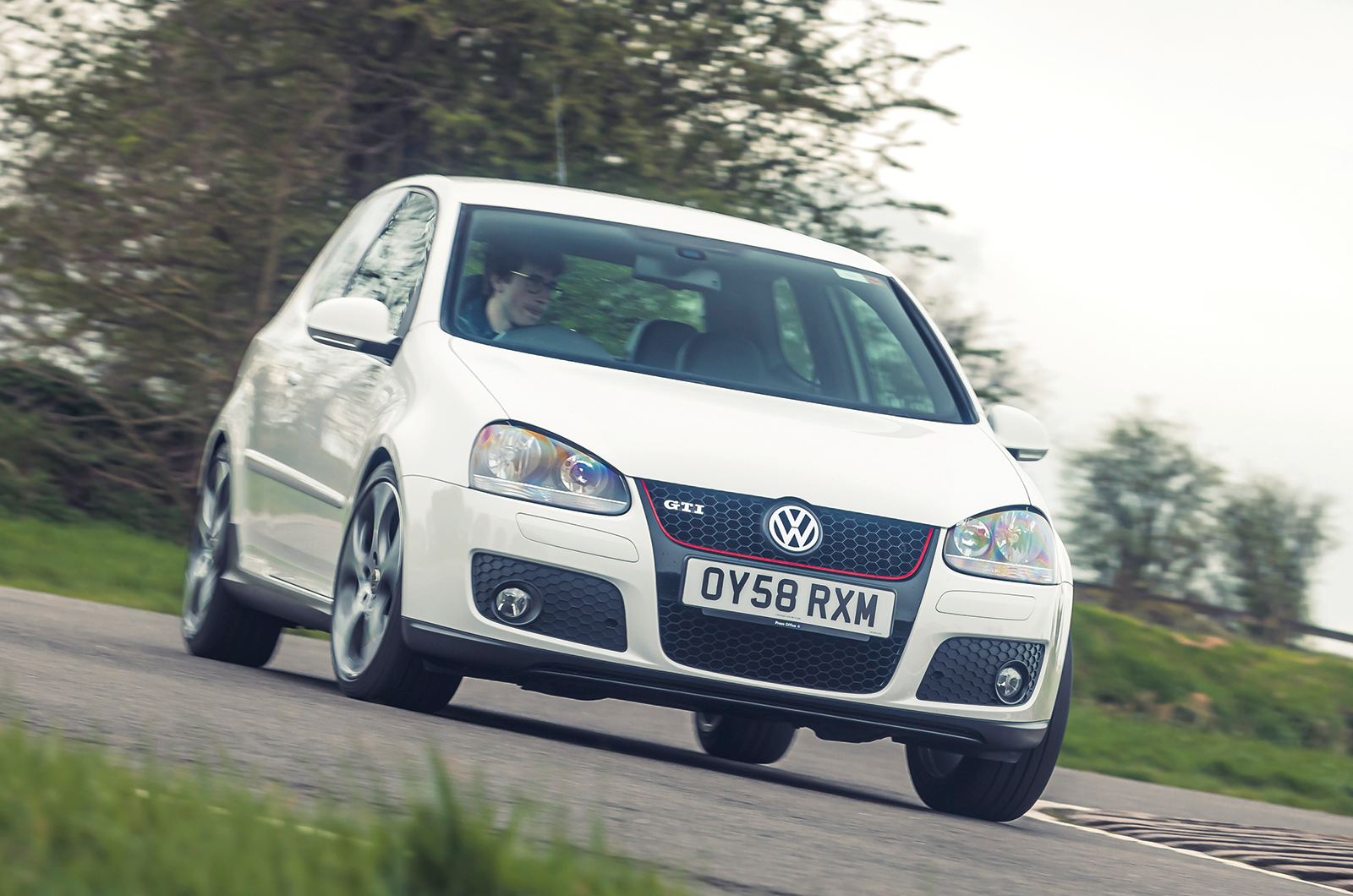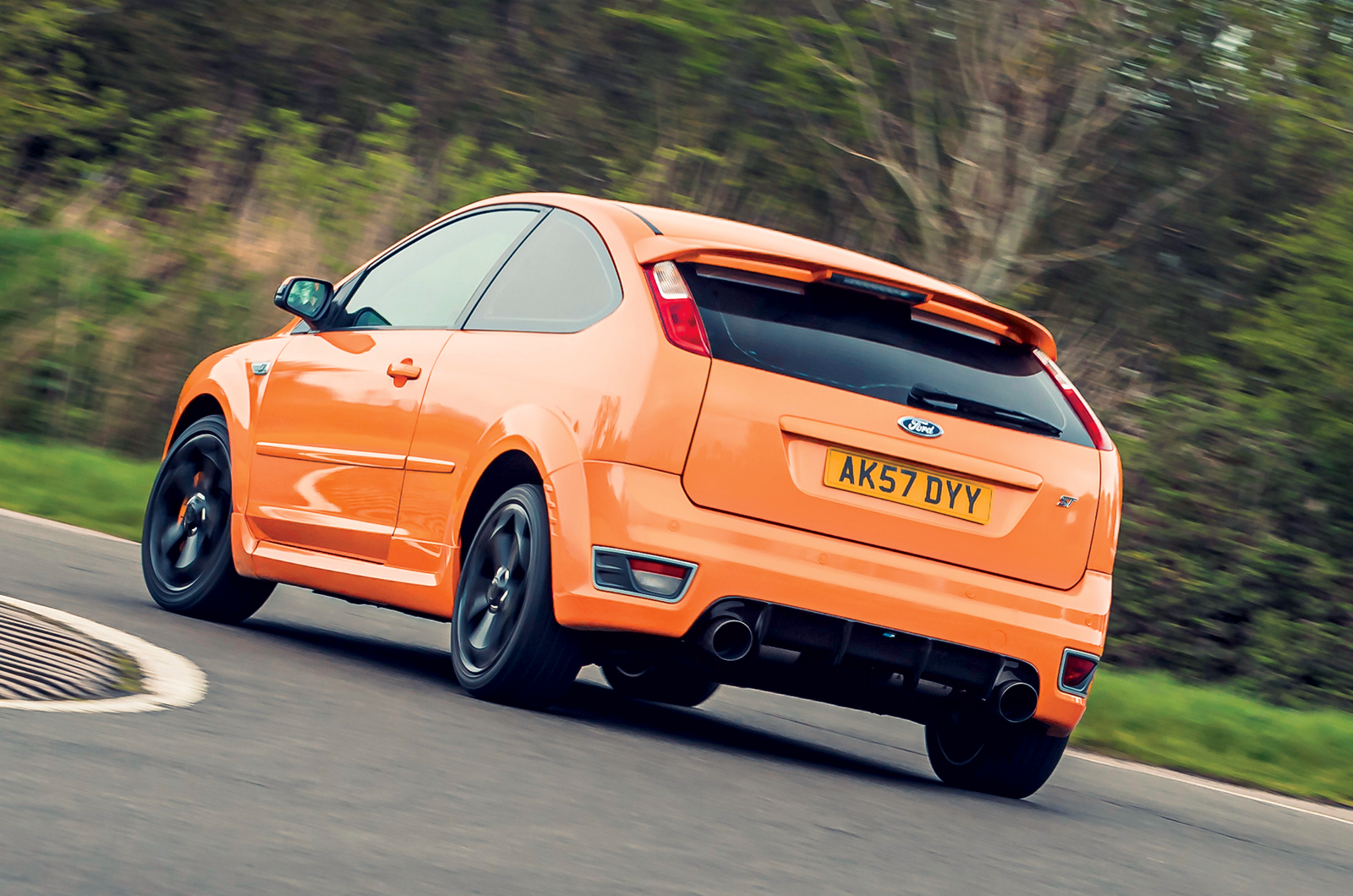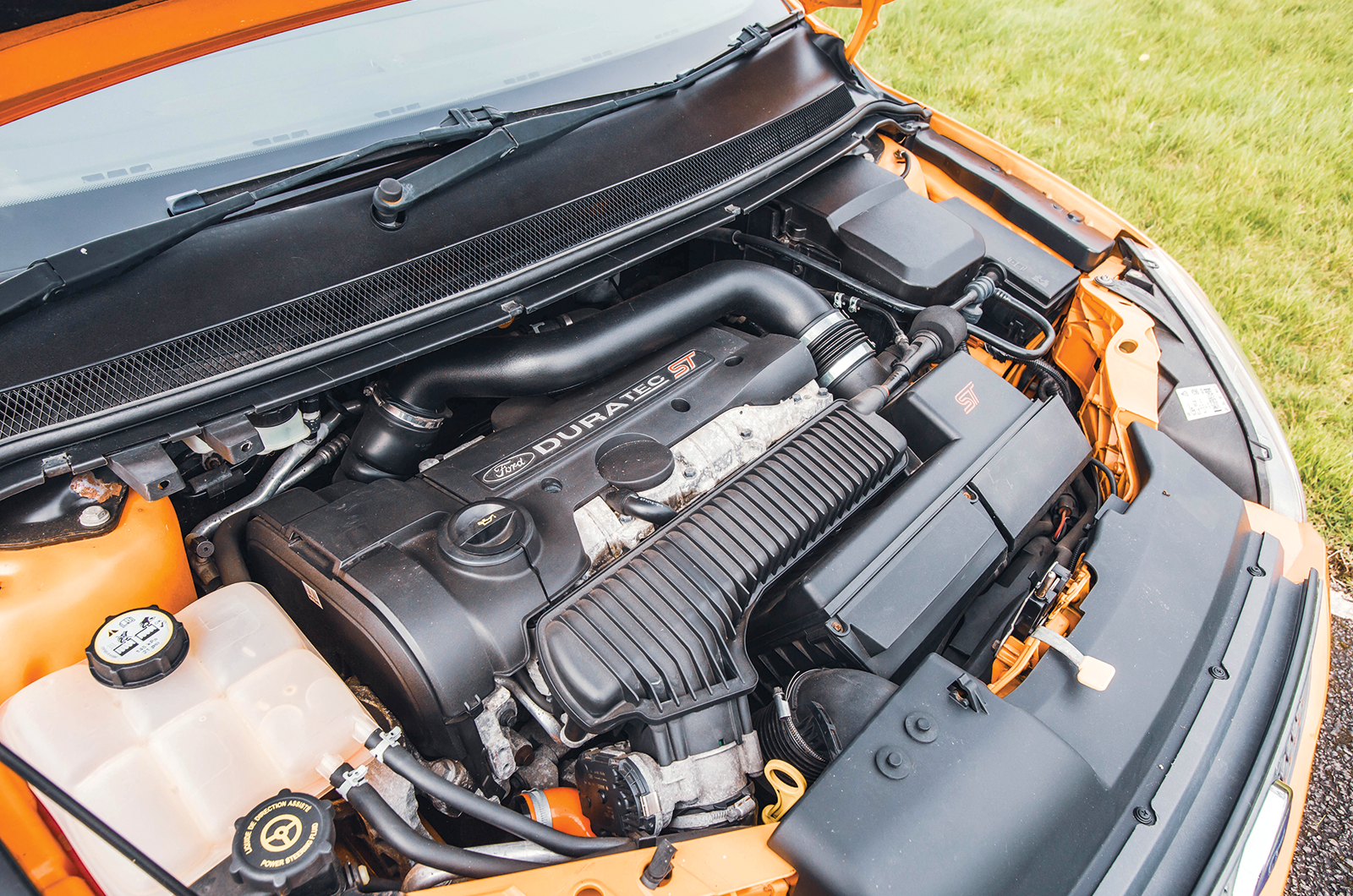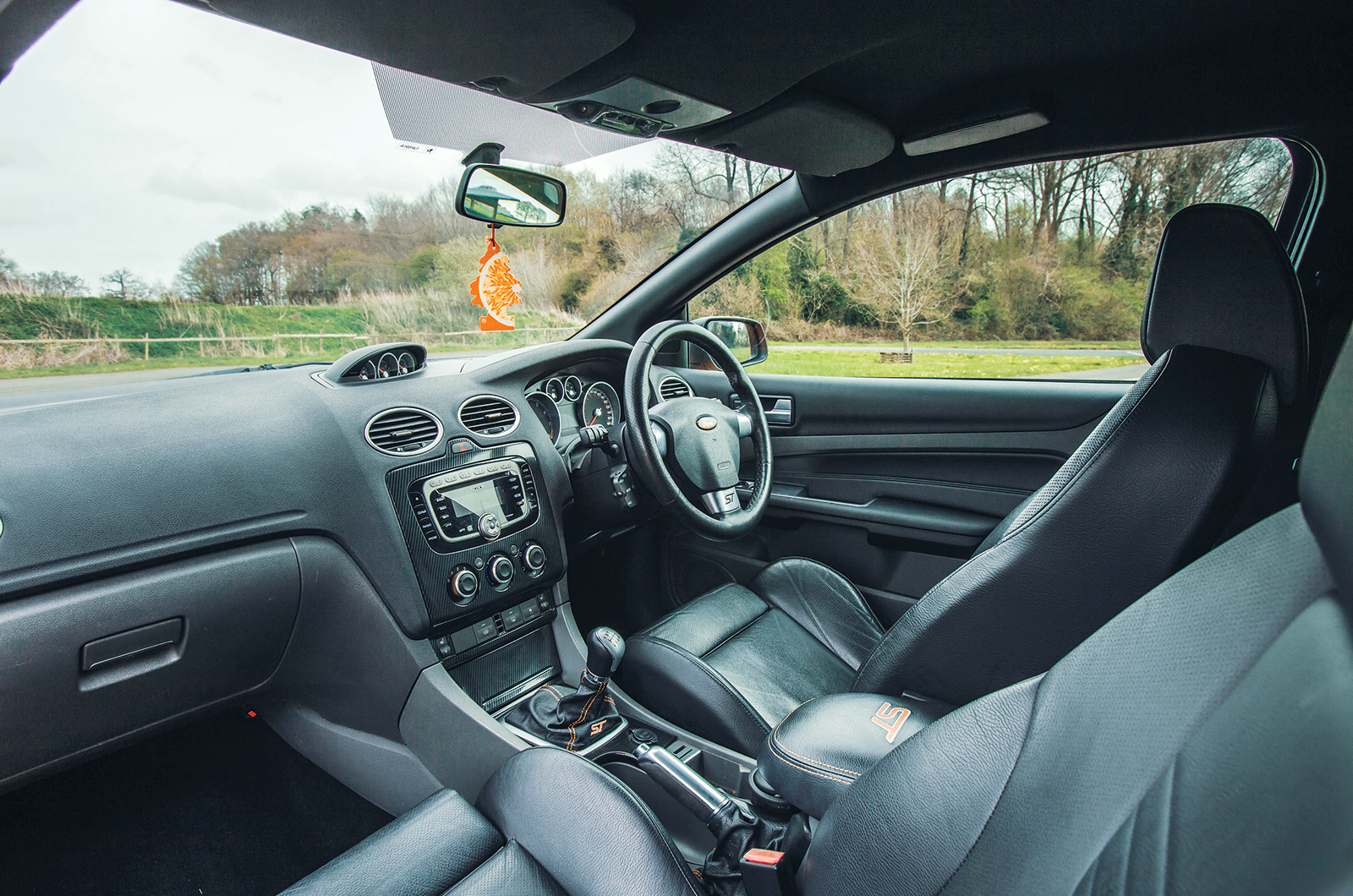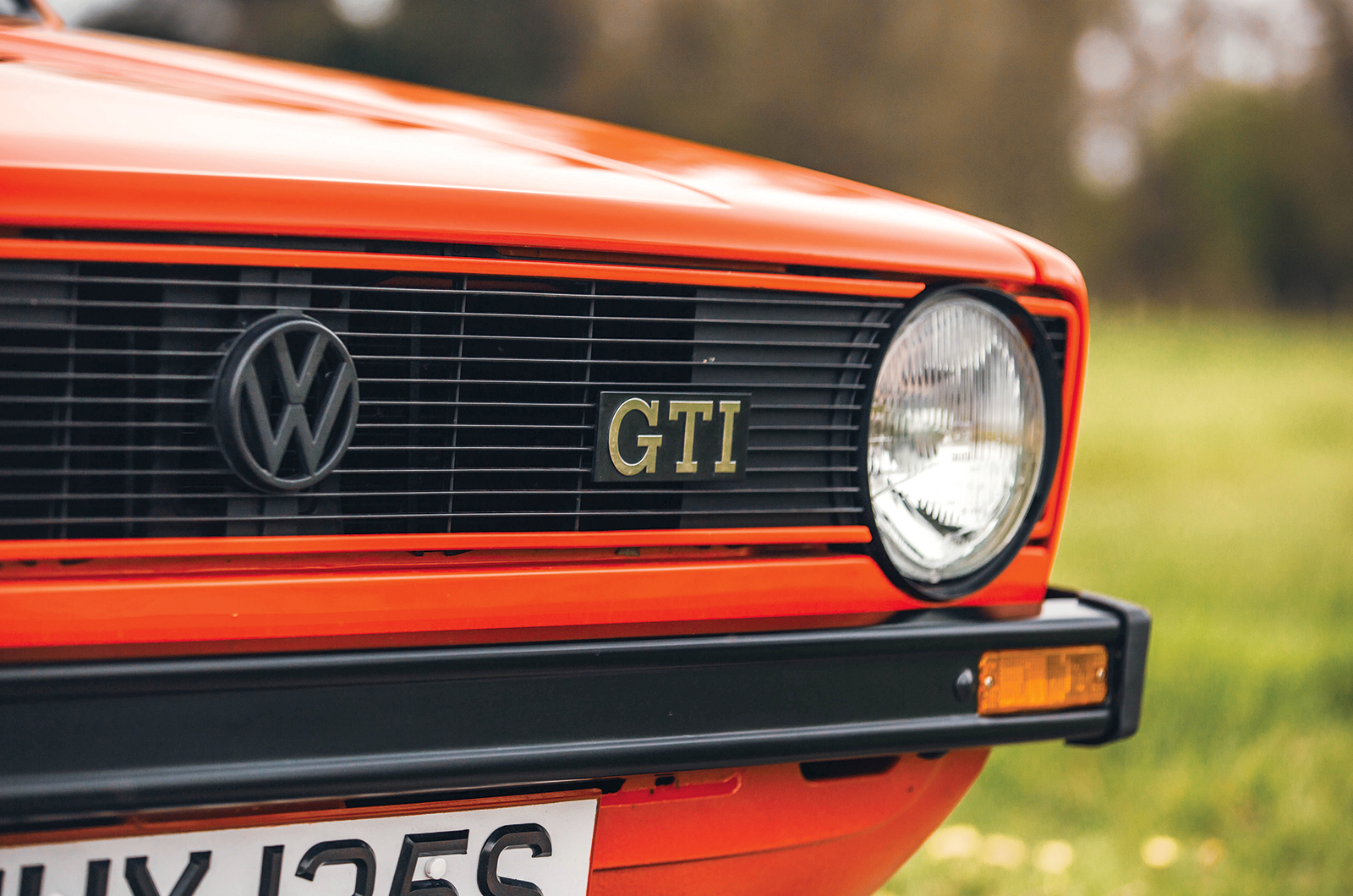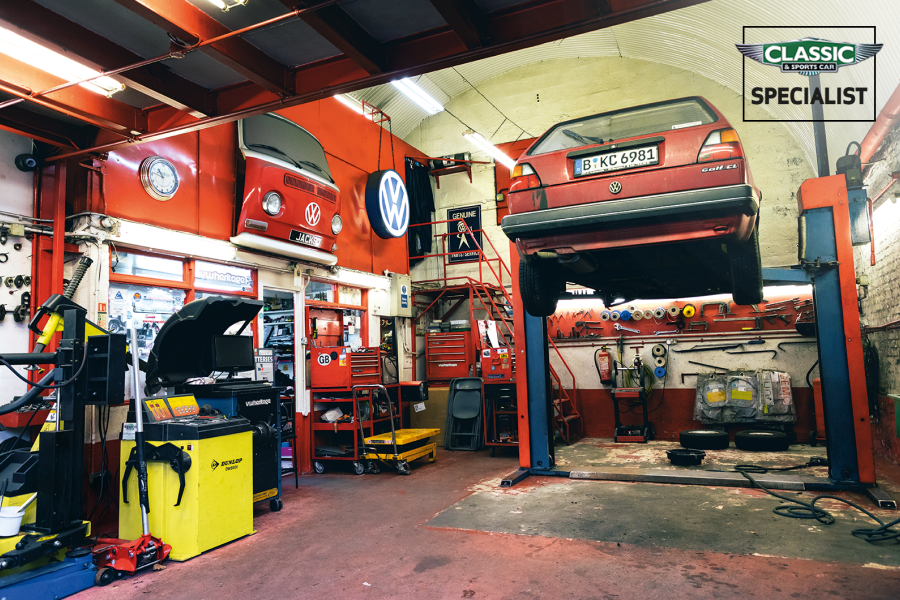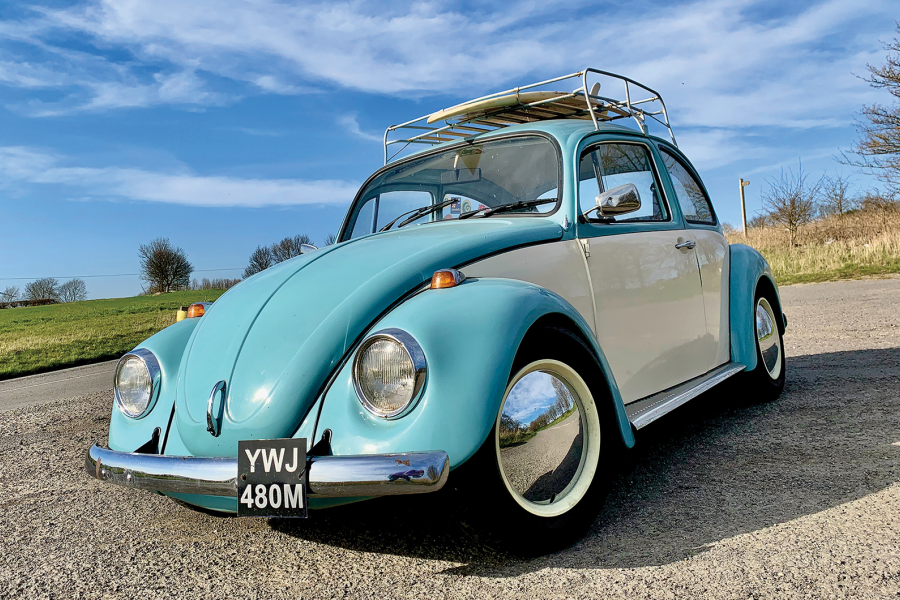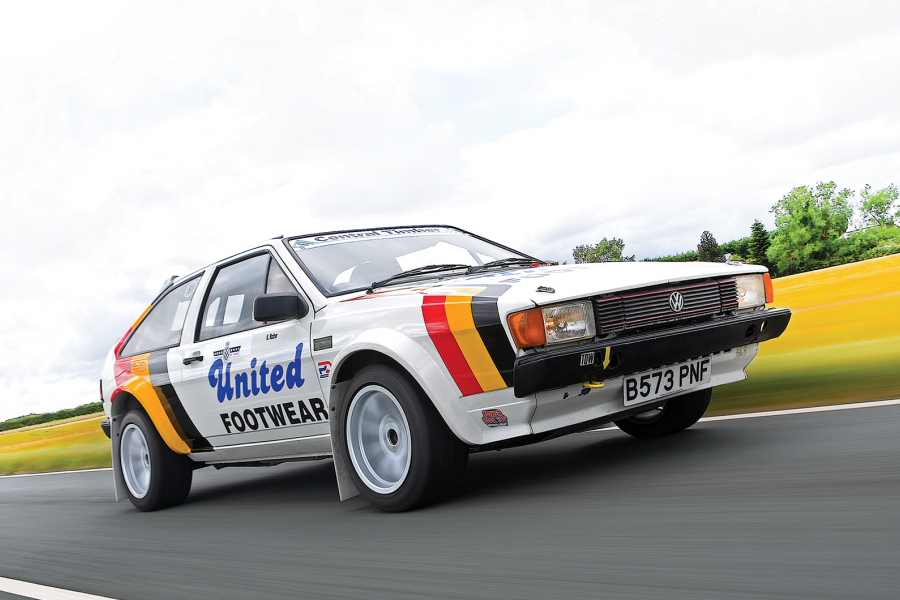With nearly half a million MkI GTIs sold, the appetite for sporting Golf variants appeared to know no bounds.
But while a direct MkII replacement was about as predictable as a Kraftwerk electro-drumbeat, so, too, was the desire to push the model’s performance envelope still further.
The situation became more urgent after the new Group A World Rally Championship class that VW had won with a GTI MkII in 1986 became every manufacturer’s target the year after Group B was banned.
So, what you see here is not only Volkswagen’s, but also Lancia’s attempt to up the class ante. Welcome to the Golf G60 Rallye and the Delta HF Integrale.
Based on the wider and longer second-gen Golf launched in 1983, the Rallye arrived in ’89 to homologate VW’s Group A entry.
It did the job properly, too: while the Rallye’s in-line ‘four’ was based on the GTI’s – albeit displacing 1763cc instead of 1781cc to comply with FIA regulations – power was boosted to 160bhp by the G-Lader supercharger, or ‘G-charger’, designed in-house.
Subtle ‘G60’ crest on the supercharged VW Golf Rallye
With crank-driven forced induction, the inherent lag of a turbo was eradicated, and in the case of the Rallye it also gave a chunky 166lb ft of torque, around 90% of which was available between 2500 and 5600rpm.
Containing this performance was VW’s Syncro four-wheel-drive system, which directed most power to the front wheels under normal conditions, but sent more rearward via a viscous coupling if traction loss was detected.
Performance took a hike, with 60mph arriving in 7.6 secs on the way to a 130mph maximum.
With its boxed wheelarches, front and rear spoilers and rectangular headlights, there was no confusing the Rallye with its lesser VW Golf brethren.
It was one of the best-equipped, too, coming as standard with part-leather trim, power steering, central locking, tinted windows and an electric steel sunroof.
Then again, priced at £18,325 in 1989 – a full £7326 more than a regular GTI – you’d expect it to be.
The VW Golf G60 Rallye’s staid cabin belies its performance
The Lancia Delta HF Integrale was equally out there on price back at its 1987 launch, costing £15,920 versus the lesser HF turbo’s £9795.
And, like the Rallye, the HF Integrale was a true homologation special, transformed by four-wheel-drive technology inherited from Lancia’s fearsome but defunct Group B S4 rally car.
As the Integrale evolved, the 4WD system’s forward bias decreased, but on this early car it sends a nominal 56% to the front and 44% to the rear.
It responds similarly to the Rallye, apportioning drive to whichever wheels need it most, in this case with a centre differential seeing to the front/rear split and a rear Torsen diff varying drive between left and right.
Being an early Lancia Delta Integrale, ‘our’ car, provided by marque expert Tanc Barratt, is a rare eight-valve model without the bonnet bulge of the later 16-valvers.
In this spec, its venerable, Aurelio Lampredi-designed Fiat twin-cam engine gives 185bhp and a generous 224lb ft, thanks to a larger intercooled turbo than that used by the regular HF turbo.
Bigger wheels and brakes, plus revised springs and dampers, completed the dynamic package, but it was the Integrale’s steroidal appearance that set it apart in the showroom.
The VW Golf MkII G60 Rallye’s supercharger gives it 160bhp
Giugiaro’s pert and pretty Delta design was emboldened with boxed arches front and rear to accommodate wider 205/50 15in tyres, along with a deep front spoiler and four headlights set into a blacked-out grille.
As the Integrale developed through 16-valve and Evoluzione models, the visuals became more extreme, but the more subtle design of the original works best for me.
It’s still not as discreet as the VW Golf Rallye, though. James Stephens has owned this car since 2013, after which it underwent an impeccable restoration.
All of which was worth doing, since James’ car is one of only 71 left-hand-drive G60 Rallyes (right-hookers were never produced) officially imported to the UK.
Looking down its flanks, the Rallye’s swollen arches appear slightly OTT for the same tyres as the Lancia, but, along with the rectangular headlights, there’s no missing that this is no ordinary Golf.
Step inside, though, and apart from the deeply bolstered half-leather seats, you could be in any executive-spec Volkswagen.
The VW (closest) and Lancia’s all-wheel-drive systems offer a nominal bias to the front wheels, but the rear comes into play more as traction and grip are depleted
A wide, neatly laid-out binnacle faces you with clocks for speed and revs, but no go-faster dials to suggest anything remotely sporting.
Turn the key, pull away and the controls respond with the precision that typifies VWs of this era – apart, that is, from the long-throw five-speed gearshift, which is slightly wooden.
Pick up pace and you note that power steering has robbed the Rallye of some of the tactility found in the MkI GTI, but it’s sensibly geared and direct enough to enjoy on Curborough’s tight sprint course.
As you extend the blown engine toward its 6000rpm redline, you note how flexible it is, how keenly it wants to rev and, for an eight-valver, how refined it is, with a near absence of supercharger whine.
The Rallye handles well: there’s tenacious front-end grip and decent rear-end adjustability, proving the worth of the Syncro’s driver-orientated set-up.
Body movements are well checked, but there’s still more roll and pitch than you’d expect from a homologation-honed car.
The Lancia Delta HF Integrale 8v has very period upholstery
The Lancia resets those expectations.
From the second you enter the cabin and face the chunky, three-spoke steering wheel, through which a plethora of yellow-etched dials are visible, you know something lairy awaits.
The driving position is long-arm/short-leg Italianate, and the wonderfully ’80s Modernist trim can’t disguise seats that don’t grip you quite as well as in the Golf.
This ex-Lancia UK press car has only covered 150 miles since an engine rebuild, so we’re respectful, but even so the Integrale feels like a tightly coiled spring waiting to be released.
The steering is far quicker than the Golf’s and almost rabidly communicative, transmitting every nuance of the road surface.
There’s less body movement than in the Rallye and, combined with greater overall grip, the Delta would be the faster car down any given piece of road just based on its chassis’ competence and sharper focus.
The Lancia Delta HF Integrale 8v’s 185bhp twin-cam engine
You then need to factor in the Integrale’s powertrain.
Its character is the diametric opposite of the Rallye: loud and aggressive-sounding, even at idle, it builds to an infectious twin-cam snarl, punctuated by the turbo’s whistle and whoosh.
Predictably, it lacks the Rallye’s low-end grunt, but from 3500-5000rpm it’s so damned hardcore in the way it shoves you down the road that it’s always worth waiting for the fireworks to erupt.
Few cars bring so much theatre to the simple process of accelerating.
Choosing between these two comes down to priorities.
The Volkswagen is the consummate all-rounder, almost belying its rally-bred origins with an enticing mix of effortless performance, road-biased dynamics and good refinement.
But it’s clear why Lancia’s Integrale racked up so many Group A victories. And, on today’s evidence, it’s just bagged one more.
Words: Simon Hucknall
Thanks to: Tanc Barratt
VW Golf MkIII VR6 vs Subaru Impreza Turbo 2000
The ’90s trend for big, torquey engines gave way to the VW Golf MkIII VR6 (closest) and Subaru Impreza Turbo 2000
The shift from MkII to MkIII VW Golf in 1992 was a pretty conservative one.
Most of the range was predictable to anyone who had spent half an hour with the brochure for the old MkII: engines, suspension and even trim levels were carried over, while increased safety, end-of-life recyclability and emissions cleanliness were the headlines.
Yet from launch there was something we’d never seen before: a six-cylinder Golf.
Volkswagen’s innovative VR6 didn’t make its debut in the Golf, having appeared a year earlier in the Passat and Corrado, where it wowed for its incredible compactness and brilliant sound.
But, by putting the engine in a family hatchback – arguably the definitive family hatchback – VW created a new segment overnight.
The VW Golf MkIII VR6’s sombre cabin
Wolfsburg didn’t develop this obscure type of engine – a vee/straight-six hybrid with the two banks sharing a cylinder head – just to get more power.
VW wanted smoothness, drivability and refinement, too: this was about making a more luxurious small family car, not just a faster one, with the practicality of a hatchback allied to a driving experience closer to that of a BMW 3 Series than a Ford Escort.
Similar ideas were percolating in Japan.
Mazda and Mitsubishi both developed tiny V6s to add refinement to small front-drive cars, the latter going down to 1.6 litres, while Subaru crammed the drivetrain of its all-wheel-drive Legacy Turbo into its new compact Impreza.
Subaru had already made a name for itself building diminutive 4WD cars in the ’80s, but those were pretty agricultural vehicles.
Like the VW Golf VR6, the Subaru Impreza – in particular the turbocharged models launched in 1994 (badged Turbo 2000 here) – offered performance and refinement only previously seen in larger cars.
The VW Golf MkIII VR6’s 174bhp engine
Let’s address the elephant in the room first: this first-generation Impreza is not strictly a hatchback, offered from launch as a four-door saloon or five-door Wagon.
The key US market preferred compact saloons, while the Wagon – really a halfway house between hatchback and estate – offered the practicality Europeans craved.
The two cars’ dimensions are almost identical, bar the Subaru tacking an extra 11 inches to its length.
More importantly to buyers in 1994, a five-door Golf VR6 and a Turbo 2000 Wagon were identically priced. Nonetheless, the VR6 and Impreza have markedly different characters.
The VW Golf is the image of refinement. One advantage of the VR6 is that it allows the balanced firing order of a straight-six, and this smoothness is evident from idle.
It’s an undersquare engine – crucial for squeezing the cylinders close together – which gives flexible acceleration, but this is blunted by the widely spaced gears.
The Subaru Impreza Turbo 2000 is equipped with grippy all-wheel drive (left); nose-heavy MkIII VW Golf VR6 can push wide
Clearly intended to be autobahn-friendly, the VR6 sits at a lazy 2800rpm at 70mph.
You have to hold a low gear to get it to do good work, but the reward is linear, gutsy acceleration, backed by a hushed yet fruity exhaust note.
That high-speed focus is evident in the chassis set-up, too: it’s immensely stable and predictable, but that comes at the expense of dulled reactions.
The steering is a touch heavy and slow, and it can’t shift its weight between corners as fluently as either its forebears or successors due to a relatively heavy body and soft springs. It’s comfortable and relaxed, but tight corners expose a heavy sense of inertia.
The Subaru Impreza can’t quite match the refinement of the Volkswagen, but it is admirably close considering the breadth of its abilities.
There’s more rattling and shaking around, but it still rides comfortably thanks to suspension with long travel to allow it to tackle rougher roads.
The Subaru Impreza Turbo 2000’s no-frills cabin
For all that, though, it doesn’t roll as much as you might expect.
Despite the Scoob’s extra weight, the 4WD system drags the car around each corner as if the front end has been lassoed by a cowboy standing at the apex.
Such manners had only been seen in Sierra Cosworths and Lancia Delta Integrales before, but the Subaru does it while riding comfortably, and with room to take the dogs to the park.
You would expect the Subaru’s turbo flat-four to be unimpressive in comparison with VW’s six-pot, but the famous ‘EJ’ matches the VR6 in both performance and character.
From a tractable 2500rpm the Subaru’s turbo piles on torque, and from 3-4000rpm it drives the car forward with a shove that compares well even to some of the newer machinery at Curborough today.
It’s not a linear experience – you have to keep the Impreza in its boosted mid-range – but the natural smoothness of a flat-four prevents it from ever being harsh or buzzy.
The Subaru Impreza Turbo 2000’s signature scoop
Both cars have remarkable engines. The VR6 is the more technically interesting, but on the road you’d struggle to choose between them. It’s the car around them that makes the difference.
Neither is a white-knuckle sporting experience, but it’s the Subaru that, in this duel of game-changers, offered the biggest step-change.
Never before had these levels of performance and practicality been offered in such an affordable, compact and agreeable package.
The VR6, meanwhile, sees a brilliant engine struggling against what proved to be the Golf’s difficult third album.
The silver lining, however, is that Volkswagen was taking notes on what Subaru had done with the Impreza and would provide a more serious chassis to accompany the VR6 just a few years later.
Words: Charlie Calderwood
Thanks to: 12 London Road and Classic Connection
VW Golf MkIV R32 vs Alfa Romeo 147 GTA
The V6-powered VW Golf MkIV R32 (leading) and Alfa Romeo 147 GTA
Volkswagen has never been one to ignore criticism.
The company never conceded the point at the time, but the feeling that the MkIII VR6 had the engine but not the chassis to equal the products of Mercedes-Benz and BMW irked insiders.
VW didn’t sell a six-cylinder Golf for the first couple of years of the MkIV; when it did, it was clear why it had taken its time.
Never again would you find a six-cylinder Golf with just front driven wheels.
When the Golf V6 (the R was dropped) returned in 2000, it nabbed not only Audi’s Haldex 4WD system, but also the TT’s close-ratio six-speed ’box and independent rear suspension.
It was still very much a premium hatch rather than a hot one, but these changes, plus the MkIV’s excellent cabin, narrowed the gap from a VW product to a luxury one much more convincingly.
The MkIV VW Golf R32’s V6 engine gives 237bhp
The turn of the millennium was a thrilling time to be a Volkswagen engineer.
Narrow, short-term profitability appeared to go out the window as Volkswagen basked in what was a golden age for Germany’s auto industry.
As the MkIV reached its final years, VW announced a 2003 model-year-only special edition: the R32. Based on the V6, the R32 nabbed even more parts from the TT, including its quick steering rack, while the engine grew to 3.2 litres.
Firmer suspension promised a much sportier drive, but committed VW fans were most excited about the way it looked.
Visual differentiators between a standard Golf and the GTI were notably absent in the MkIV, but there was no mistaking an R32.
Gaping front airdam, 18in wheels, twin exhausts and bucket seats made for the most stirring-looking VW Golf in years.
The Volkswagen Golf R32 has a solid, well-built cabin
Alfa Romeo must have been partly inspired by VW when, in 2003, it put the hallowed ‘Busso’ V6 into its 147 family hatch.
In fairness, Alfa did have a practice run: squeezing the engine into the Type 916 GTV was impressive, albeit leading to some hellish servicing operations.
Unlike the VR6, the Alfa V6 had no special packaging to help it fit into smaller cars, but, style as ever being prioritised over substance at Arese, the 147 had a long enough nose to make it work.
The drivetrain was lifted straight out of the 156 GTA, as was the double-wishbone rear suspension, brakes and infamous short-lock steering rack. Bulging arches and more aggressive aero addenda finished the job.
Neither the GTV6 nor 156 GTA were excellent handlers, but Alfa had shown clear progress between the two – and that only improved further with the 147.
It finally managed to escape the overwhelming front heaviness of those cars: at Curborough it’s adjustable at the rear without being snappy, and it’s eager to shift its weight.
The Alfa Romeo 147 GTA (left) has lots of torquesteer; the VW Golf R32’s four-wheel drive provides epic traction out of corners
It even rides reasonably well, certainly more comfortably than the stiff R32.
Driving only through its front wheels, the Alfa Romeo 147 GTA has to be treated with a level of respect unfamiliar in hot hatchbacks of its era.
On a perfectly smooth track, and with a firm grip of the wheel, you can nail the throttle and it’ll provide savage acceleration thanks to its 247bhp; as a bonus, it has an engine note that genuinely rivals a Ferrari V8 with its soulful, gargling roar.
But push on the throttle with any kind of steering lock, or on a rough surface, and the car’s reputation for torquesteer is manifest: it will pull at the wheel and drag you off line.
It’s not unmanageable but requires the sort of restraint you’d be more used to deploying in a light, powerful rear-wheel-drive car that doesn’t have the benefit of traction control.
VW’s R32 needs no such accommodation, putting its power down instantly, without fuss, by shifting all of the car’s power between the front and rear axles.
The Alfa Romeo 147 GTA’s tight-fitting 3.2-litre ‘Busso’ V6
A real hair-trigger throttle only adds to this sense of immediacy: as soon as you’re even vaguely round a corner, you can stomp on the pedal and warp away in an instant.
Plus, the subtle growl of the VR6 in the old MkIII has now developed a thrilling warble.
As quick as the Alfa Romeo 147 GTA is on paper, in the real world there’s no doubt that the R32 is the faster car – and the fastest here today.
That’s not to say it’s perfect, however. The interior, though very well built, doesn’t get close to the evocative design or luxurious seats of the little Alfa.
The ride is firm and the clutch a little too heavy, and, as capable as the chassis feels, it can’t hide its 1477kg.
This isn’t a car that dances through corners, delighting the driver with the feel of each suspension arm moving underneath; instead it barges its way around, pounding the road into submission as it rips up the Tarmac to pull itself through.
Just 5029 Alfa Romeo 147 GTAs were built between 2002 and ’05
That the 147 sold half as well as the VW over a much longer production run might be more a reflection of Alfa Romeo’s mismanagement than of the car itself. Its engine is fantastic, a marvel even, while its design is rousing.
But its raucous nature, the raw experience that comes from cramming too large an engine into a small front-drive car, does feel old-fashioned compared with the R32.
Some will love the Alfa for that, but it’s the Golf that moved the game along, and in doing so it anticipated the future direction of a new generation of ‘super hatch’.
In this one model, VW not only relit the fire of the hot Golf, providing an instant antidote to a decade of GTIs that hadn’t matched those of the 1980s, but also started a new Golf dynasty.
The VW Golf MkIV R32 proved so popular in its single model year that not only did it go beyond its initial production estimates, but an R model has returned in every subsequent generation.
For many, they have become the go-to solution for subtle, practical performance.
Words: Charlie Calderwood
Thanks to: Brian Smith
VW Golf MkV GTI vs Ford Focus ST
The MkV VW Golf GTI (right) and Ford Focus ST were two of the biggest players in the mid-2000s hot-hatch fray
Hot-hatch fans were spoiled in the mid-2000s: most manufacturers were in on the game, and power outputs were climbing fast.
It was in this crucible of competition, where every tenth of a second to 60mph mattered, that the GTI experienced a rebirth from which it continues to excel to this day.
Aficionados will argue for ever about which is the best GTI, but none would deny the MkV was the single biggest improvement in the model’s history.
Chief among the competitors to wake the GTI from its stupor was Ford. All who drove even the humble 1.6 were wowed by 1998’s Mk1 Focus, which brought multi-link suspension to the segment alongside a fantastically tuned chassis.
The front-wheel-drive Golf MkIV was embarrassingly stodgy in comparison.
The VW Golf MkV GTI’s 197bhp EA113 ‘four’
The quickest way to solve the issue was to poach one of Ford’s people.
Ferdinand Piëch first went for Richard Parry-Jones, but gave up when he found out that a recent promotion to group vice-president meant ‘RPJ’ earned more than Piëch himself.
Instead, VW swooped in for vehicle dynamics manager Ulrich Eichhorn, who, having spent a year on a Focus-based MPV that had just been canned, was amenable to the approach.
The MkV VW Golf came out in 2003 with multi-link rear suspension on all models and a chassis within a hair’s breadth of Ford’s Focus.
A good base to work from was half the battle in making a decent GTI, but VW continued responding to other criticisms of the old model.
For one, the GTI was now easily distinguishable from other Golfs: the red grille border was back for the first time in more than a decade, while the ‘radioactive warning symbol’ alloys quickly became famous.
The VW Golf GTI’s ‘Monza’ alloy wheels
More subtly, the VW Golf GTI front bumper bar gave the car a slightly pointier nose, while tartan seats returned as standard equipment.
Under the bonnet, VW deployed the 197bhp 2-litre turbo first seen in Audi’s A3, at last giving the GTI competitive performance.
Ford wasn’t resting on its laurels, though.
When the rumours of a successor to the Focus ST170 in the new Mk2 surfaced, the assumption was that Ford would follow VW, Vauxhall and Renault in offering it with a 2-litre turbo; few expected the firm to pull the five-cylinder turbo out of a Volvo.
Appearing just a year after the GTI, and £1500 cheaper, you can imagine Volkswagen feeling it couldn’t catch a break.
The MkV VW Golf GTI’s smart cabin
Displacing 2.5 litres, the ST engine’s torque is the first thing you notice.
It is strong from incredibly low revs and reasonably quiet at a cruising part-throttle, but a strong right foot will elicit a gruff, five-cylinder gurgle that was deliberately engineered to find its way into the cabin.
Unusually for a hot hatch, it isn’t an engine you feel much desire to rev because it pulls so hard in the mid-range, and there’s little extra oomph to be had above 5000rpm.
The example with us today has slightly more volume than standard, but even stock exhausts were noted for their rally car-like bangs and crackles.
It isn’t the most sophisticated-sounding car, but its yobbish soundtrack is a perfect fit with the Electric Orange paintwork.
The VW Golf GTI regained its chassis mojo for its fifth generation (left); the Ford Focus ST is superbly balanced
The Ford’s chassis is refined in a manner completely at odds with its blocky bodykit.
It’s a spot-on balance of ride comfort and firmness for British roads, and it corners with immense agility and predictability.
Its turn-in is well-judged, tucking into the apex with real verve, but never leaving its rear axle wayward as some of its more crude contemporaries love to do.
The only disappointment is the steering: it’s good for the time, direct and reasonably quick, but lacking the feel of the older, lighter Mk1.
The Volkswagen doesn’t brag about its talents from the off in the way the Ford does.
Its engine is much more subtle at low revs, and around town it feels similar to a cooking Golf if you drive it like one: friendly, usable and a little bit dull.
The Ford Focus ST’s flexible five-cylinder motor came from Volvo
Push it harder, though, and you find a pugnacious, tractable powerplant that gives it a satisfyingly rorty exhaust note at higher revs.
It’s brilliantly chuckable, too: the friendly chassis encourages you to play with more aggressive steering inputs or carry a bit of extra speed into successive corners.
There’s no part of the Golf’s user experience, whether it’s clutch, brakes, gearshift or driving position, that doesn’t feel well considered and exceedingly exploitable. It even rides well. Only the Ford’s slightly keener turn-in edges ahead.
Like the Focus, the sole disappointment is an electronically assisted steering rack that’s a bit numb, although it is very precise.
Of all the pairings here, this is one of the hardest to call.
The Ford Focus ST’s interior lacks polish compared with the MkV VW Golf
These two hot hatchbacks’ characters are remarkably similar; they are both exceptional all-rounders with well-honed chassis that remain driveable and comfortable.
The extra size of the Ford’s five-pot gives it that bit more flexibility, and it’s a better-sounding motor. If you buy your cars primarily for their engines, you’ve got to have the Ford.
The VW, though, better fulfils many of the more usual elements of the hot-hatch brief.
Its interior is nicer than the Ford’s, it’s far kinder on fuel and its exterior has an air of refinement that allows the mild-mannered geography teacher to enjoy it as much as the McFlurry-wielding boy racer.
That’s true of its driving manners, too. It gives exactly what its driver puts in and is never surprising or a let-down.
The MkV recaptured the ‘all things to all people’ magic of the early GTIs, and that’s what makes it a true milestone.
The Ford Focus is very good, but the VW Golf is an all-time great.
Words: Charlie Calderwood
Thanks to: Sam Wilcox; Volkswagen
Factfiles
VW Golf MkI GTI
- Sold/number built 1975-’83/456,690
- Engine iron-block, alloy-head, sohc 1588cc ‘four’, Bosch K-Jetronic fuel injection
- Max power 108bhp @ 6100rpm
- Max torque 101lb ft @ 5000rpm
- Transmission four-speed manual, FWD
- Weight 1786lb (810kg)
- Mpg 26.9
- 0-62mph 8.9 secs
- Top speed 113mph
- Price new £7156 (1983)
- Price now £15-30,000*
Vauxhall Astra GTE MkI
- Sold/number built 1983-’84/9281
- Engine iron-block, alloy-head, sohc 1796cc ‘four’, Bosch LE-Jetronic fuel injection
- Max power 115bhp @ 5800rpm
- Max torque 101lb ft @ 4800rpm
- Transmission five-speed manual, FWD
- Weight 2039lb (925kg)
- Mpg 29
- 0-60mph 8.5 secs
- Top speed 115mph
- Price new £6739
- Price now £10-25,000*
VW Golf MkII Rallye
- Sold/number built 1989-’92/5000
- Engine iron-block, alloy-head, sohc 1763cc ‘four’, Bosch Digifant fuel injection, G-Lader twin-scroll supercharger
- Max power 160bhp @ 5600rpm
- Max torque 166lb ft @ 4000rpm
- Transmission five-speed manual, 4WD
- Weight 2635lb (1195kg)
- Mpg 30.3
- 0-60mph 7.6 secs
- Top speed 130mph
- Price new £18,235
- Price now £20-35,000*
Lancia Delta HF Integrale 8v
- Sold/number built 1987-’89/9841
- Engine iron-block, alloy-head, dohc 1995cc ‘four’, Weber fuel injection, Garrett T3 turbocharger with air-to-air intercooler
- Max power 185bhp @ 5300rpm
- Max torque 224lb ft @ 3500rpm
- Transmission five-speed manual, 4WD
- Weight 2679lb (1215kg)
- Mpg 30.1
- 0-62mph 6.6 secs
- Top speed 134mph
- Price new £15,920
- Price now £25-45,000*
VW Golf MkIII VR6
- Sold/number built 1991-’98/4.8m (all models)
- Engine iron-block, alloy-head, sohc-per-bank 2792cc V6, Bosch fuel injection
- Max power 174bhp @ 5800rpm
- Max torque 173lb ft @ 4200rpm
- Transmission five-speed manual, FWD
- Weight 2544lb (1155kg)
- Mpg 24
- 0-60mph 7.1 secs
- Top speed 138mph
- Price new £17,545 (1994)
- Price now £5-15,000*
Subaru Impreza 2000 Turbo
- Sold/number built 1994-2000/c740,000 (all models)
- Engine all-alloy, dohc 1994cc flat-four, Hitachi fuel injection and IHI TD04 turbocharger
- Max power 208bhp @ 6000rpm
- Max torque 201lb ft @ 4800rpm
- Transmission five-speed manual, 4WD
- Weight 2674lb (1213kg)
- Mpg 20
- 0-60mph 6.1 secs
- Top speed 137mph
- Price new £17,999 (1994)
- Price now £5-20,000*
VW Golf MkIV R32
- Sold/number built 2002-’03/10,062
- Engine iron-block, alloy-head, dohc-per-bank 3189cc V6, Bosch fuel injection
- Max power 237bhp @ 6250rpm
- Max torque 236lb ft @ 2800rpm
- Transmission six-speed manual, 4WD
- Weight 3256lb (1477kg)
- Mpg 24
- 0-60mph 6.6 secs
- Top speed 153mph
- Price new £22,340 (’03)
- Price now £10-20,000*
Alfa Romeo 147 GTA
- Sold/number built 2002-’05/5029
- Engine all-alloy, dohc-per-bank 3179cc V6, fuel injection
- Max power 247bhp @ 6200rpm
- Max torque 221lb ft @ 4800rpm
- Transmission six-speed manual, FWD
- Weight 2998lb (1360kg)
- Mpg 21
- 0-60mph 6.1 secs
- Top speed 153mph
- Price new £22,450 (’03)
- Price now £10-25,000*
VW Golf MkV GTI
- Sold/number built 2004-’08/3.4m (all models)
- Engine all-alloy, dohc 1984cc ‘four’, fuel injection, Borg-Warner K03 turbocharger
- Max power 197bhp @ 5100rpm
- Max torque 206lb ft @ 1800-5100rpm
- Transmission six-speed manual, FWD
- Weight 3011lb (1366kg)
- Mpg 35
- 0-60mph 7.2 secs
- Top speed 146mph
- Price new £19,995 (2005)
- Price now £5-15,000*
Ford Focus ST
- Sold/number built 2005-’10/n/a
- Engine all-alloy, dohc 2522cc ‘five’, fuel injection, Borg-Warner K04 turbocharger
- Max power 222bhp @ 6000rpm
- Max torque 236lb ft @ 1600-4000rpm
- Transmission six-speed manual, FWD
- Weight 2903lb (1317kg)
- Mpg 28
- 0-60mph 6.5 secs
- Top speed 150mph
- Price new £18,495 (2005)
- Price now £5-15,000*
*Prices correct at date of original publication
Enjoy more of the world’s best classic car content every month when you subscribe to C&SC – get our latest deals here
READ MORE
Renault 5 GT turbo vs Lancia Delta HF turbo ie: small cars, big punch
Your classic: Volkswagen Golf GTI
Future classic: VW Golf GTI TCR
Classic & Sports Car Editorial team
